#the most hideous era of game design
Explore tagged Tumblr posts
Text
57 Best Computer Companies – Best Laptops
Welcome to the 21st century, the era of technology. For the one who grows in the 20th century, you will feel the gradual changes in many aspects. Right now, we can access super-fast email, play 3d games, type quickly, design your dream house, and even do face-to-face phone calls in one device.
Yes, you can amalgamate all the different tasks into one gadget using a computer. Even a device called a laptop, a portable computer with similar functions.
All of these daily tasks can be accomplished due to the hard work of computer companies. With their immense contributions to the world, we can easily access anything, even work remotely from our house. Furthermore, you can do any job using the software from your small yet compact laptop. Thanks to computer companies, you can reap all of these benefits.
However, among all of the companies scattered in the world, there should be some of them that hold more importance as the best computer company compared to others. Do you have a question – who is the best computer company in the world? Who are the top computer companies? What are the world’s best computer companies? Here are the 57 best computer companies –
LIST COMPUTER COMPANIES
• MICROSOFT
Who doesn’t know Microsoft nowadays? Microsoft is one of the best computer companies in the world. People, especially those who work with the computer for daily tasks, will recognize it. This giant company is one of the most important corporations in decades, with its Microsoft windows products standing the most. Microsoft Windows is an operating system that more than 1,5 billion people use. What a hideous amount! Not only that, but they also produce many things aside from operating systems and software, such as smartphones, laptops, and gaming consoles (X-Box series).
• APPLE
Aside from Microsoft, there is also its biggest rival. Apple is a visionary computer company that changes the world with the “Bitten Apple” symbol as its signature. It is one of the top brands compared to other top computer companies.
From a small company selling computers, Apple grew to a multinational company offering versatile products. Their signature lies in their developed operating system, macOS, which is on par with Microsoft windows.
Apple, also known for its visionary works, combines all utilities inside one gadget, which they call iPhone. Aside from the iPhone, they also produce other devices such as MacBook, Macintosh, iPad, and many more.
• HEWLETT- PACKARD (HP)
Talking about the computer, HP, without a doubt, is one of the best computer companies. Originating from California and Los Angeles, HP provides hardware and software services. Although their first product was an audio oscillator, the founders quickly turned HP to become a computer company. Not only for business and working occasions, but HP will also give you a computer gaming experience with its Legion Series.
• DELL
Although Dell’s company is still relatively young compared to the others, the company still has high credibility. Dell Inc. is a multinational computer company based in Round Rock, Texas. Not only sell computers, but Dell also provides services and computer repairs. However, Dell has also expanded its market to television and digital camera producers, making them one of the giant computer corporations in the world.
• LENOVO
Last but not least, here comes Lenovo. Compared to other brands mentioned here, Lenovo is the only one not originating from the United States. Based in Beijing, China, Lenovo became one of the most influential computer companies. Lenovo’s products may vary. It encompasses not only personal computers but also smartphones, tablet computers, smart TV, IT software, tablet computers, and even servers. Even in 2013, Lenovo obtained the highest personal computer unit sales.
SAMSUNG
Headquartered in Seoul, South Korea, Samsung is one of the big companies comprising many affiliated businesses.
Still, it is most known as an electronics provider. Samsung significantly influences economic development, politics, culture, and media in South Korea.
INTEL
Intel Corp. is an American technology company and multinational corporation. It is the inventor of microprocessors found in most PCs (x86 series) and a supplier for other large businesses, such as Dell, Apple, and Lenovo.
SONY
Sony began in 1946 in Japan and has since come a long way. This company is one of the leading electronics manufacturers for the professional market and consumers, owns the most extensive music entertainment business worldwide, the largest video game console industry, and is a significant player in the television and film industry.
ASUS
Founded in 1989, ASUS is an electronics and computer hardware company. The products they provide include desktop computers, tablet computers, laptops, mobile phones, optical disk drives, servers, computer monitors, graphic cards, and more.
ACER
This Taiwanese multinational electronic and hardware corporation was founded in 1976. It specializes in advanced electronics technology. The company provides numerous excellent products besides computers and tablets, including servers, V.R. devices, displays, and smartphones.
IBM
IBM (International Business Machines), beginning in 1911, is an American company that produces and sells software, middleware, and hardware, providing consulting and hosting services. It is also an important research organization.
RAZER
Razer Inc. began in San Diego in 1998 and currently has its headquarters in Singapore and California. The company specializes in manufacturing gaming hardware and esports and provides financial services.
ALIENWARE
Founded in 1996 and headquartered in Miami, Alienware is a computer hardware branch of the company Dell. The products they provide are designed for gaming and can be quite easily identified due to their alien-themed style.
PANASONIC
Panasonic Corp. began its path in 1918 as a manufacturer of lightbulb sockets. Today, it is one of the leading multinational electronics companies in Japan. Besides consumer electronics, the company also offers a broad range of services and products, such as rechargeable batteries, avionics, automotive systems, and, believe it or not, home renovations.
TOSHIBA
Toshiba is a diversified Japanese company. It provides various services and products, including social and industrial infrastructure, escalators and elevators, electronic components, printers, hard disc drives, lighting, and I.T. solutions.
IBUYPOWER
Cutting-edge technology, reliability, fantastic performance, and timely productions are the elements that make iBuyPower a leading name in P.C. gaming. In addition, their computers come with a graphic card that enables a more immersive gaming experience and enough room for future updates.
MSI
MSI (Micro-Star International Co.) was established in 1986 in Taiwan. Their business focuses on developing, designing, and providing computer hardware and related services and products, such as desktops, laptops, graphic cards, and motherboards.
L.G.
L.G. Electronics has become more popular globally due to its mobile phone production. Still, the company provides a wide range of excellent electronics. It consists of four branches; mobile communication, home entertainment, home appliances, and vehicle components.
NOKIA
Nokia is a Finnish company with a long and successful history; it has been with us since 1865. In addition to telecommunication technology, they also provide consumer electronics and Information Technology.
FUJITSU
This Japanese I.T. services and equipment company mainly focuses on producing computing products but also offers services and products for enterprise, personal computing, telecommunications, storage products, and air conditioning.
NEC
Before rebranding in 1983, the company was named Nippon Electric Company, Limited. It provides network and I.T. solutions, including IoT platforms, cloud computing, and 5G network, to business ventures and government agencies.
GATEWAY INC.
Gateway was a computer hardware company that manufactured, developed, marketed, and supported a broad range of PCs, computer monitors, and servers. In the year 2007, it was acquired by Acer.
COMPAQ
Before merging with H.P., which discontinued the brand name, Compaq had been a company that developed, supported, and sold computers and other related services and products.
IBALL
This Indian electronics company initially started operating by selling computer mice in 2001. Still, it quickly became a big importer of smartphones, tablets, and computer peripherals from original manufacturers.
EMACHINES
eMachines was a personal computer brand that Gateway Inc. acquired in 2004. Unfortunately, that did not last long either since Acer took over Gateway. As a result, the name eMachines was discontinued in the year 2013.
VELOCITY MICRO
Located in Virginia, USA, Velocity Micro is a private boutique specializing in manufacturing custom-assembled high-performance gaming computers and computer solutions.
HCL TECHNOLOGIES
This Indian company HTC Technology Limited had initially started as a research and development division of HTC, but in 1991, it arose as an independent company when they started with the software services business.
ZEBRONICS
Zebronics has been making excellent and affordable products for years. The company began operating in 1997 in India, selling various quality headphones and earphones.
SPRINT CORPORATION
Before T-Mobile U.S. acquired it in April 2020, Sprint had been one of the largest U.S. mobile network operators, offering also messaging and wireless voice. However, the brand’s name was officially discontinued in August 2020.
Via - https://techkow.com/best-computer-companies/

0 notes
Text
AGD Interactive remade Quest for Glory 2 from EGA to VGA, and it was nice. Not necessary, I felt, but nice.
I never played QFG5 before, because it was the time when all games decided they had to be darkity dark and serious, which Sierra jumping on was particularly terrible. I’ve heard lately that it does still carry the tone of the rest of the games, only a little more serious, not a total trainwreck like King’s Quest 8. So I’m giving it a try. The intro with actual throat-slitting is giving me pause. I’m fine with violent and serious games, but in this series, no. I’ll keep going and see how it turns out though.
But ye gods and little fishes. The graphics are horrible. Could someone please remake Quest for Glory 5 from hideous-era 3D to VGA? Or EGA. I’m not picky.
#non-sims#other games#quest for glory#this is also why I will never replay the KOTOR games#the most hideous era of game design
1 note
·
View note
Text
Screw AFI: Write Your Own Favorite Movie Moments
(then tag 3 people)
Every continuation of the artist narrating the process of her art in Artemisia.
Haggar describing his one happiness being driven into the sea in The Last Unicorn.
The fight between Fly and Rex in Babe.
The witch in her cave assisting Ichabod in Sleeping Hollow (1999).
The Little Mermaid’s (1975) dignified and unromantic death.
Moro’s conversation with Ashitaka on her bed at the height of a mountain peak in Princess Mononoke.
The entire Eccentric Circle debacle at the end of We’re Back! A Dinosaur Story.
Balto’s exhilarating encounter with the White Wolf.
“Tell him--” “No. He won’t even know your name.” Which was just EVERYTHING that ending needed in Pan’s Labyrinth.
Every moment of magical, interconnecting happenstance in Tokyo Godfathers.
The regret, reality and grief felt over the Wolf’s death in Chirin’s Bell (The Ringing Bell).
A Goofy Movie’s Powerline concerts (BOTH OF THEM).
Kocoum’s death and the subsequent guilt shown by Thomas; Pocahontas.
The entire goddamn freedom fight in the street’s before the church; Hunchback of Notre Dame.
The verbal smackdown at the breakfast table between Kat and Stretch in Casper.
That terrifying chase through the house with Trunchbull, Miss Honey and Matilda.
How “The Wishing Star Belongs to Me” and “The Cave of Your Worst Nightmares” play off of each other hilariously; Wakko’s Wish.
Rose on the boardwalk after surviving the Titanic.
Meg Ryan’s entire presentation of doing her best and finally just fucking snapping in the hospital in Hanging Up.
Pip saving Zak from falling to his death before assisting him into a cup of coffee; Ferngully: The Last Rainforest.
Camille and Flip sassing each other in Little Nemo: Adventures in Slumberland.
Derek constantly fucking up and then doing his best to make it up to Odette (dat final battle scene, unf); The Swan Princess.
Nekron being completely and totally gay (complete with being repulsed by Teegra and WAY into Larn) in Fire & Ice.
Shinbone Alley’s Archie in his hopeless yet enduring devotion to Mehitabel.
Casablanca’s ending with Louis saving Rick’s ass and the both of them walking off into the night together.
Kala absolutely being the best damn mother in the entirety of the Disney Renaissance era; Tarzan.
Jetsons: The Movie musical numbers; how else would you be able to observe the culmination of the ‘80s style and taste?
The Beetle being the epitome of sleeze, which makes it all the more enjoyable to see him suffer; Thumbelina.
The crows being the only competent and actually kind characters other than Timothy in Dumbo.
Tony’s last “Goodbye” to Pete; American Pop.
The first introduction and the so-called final death of Erik’s music in The Phantom of the Opera (1989).
Munkustrap’s enthralling fight with Macavity; Cats (1998).
“The way of the future,” repeat, repeat, repeat; The Aviator.
Cera’s return to the herd and defeat of the Sharptooth; The Land Before Time.
Claudandus in his last conversation in justifying his motives and murderous intent in Felidae.
Black Phillip finally revealing his voice and thereby Himself; The Witch.
Snape protecting the trio with his own body from the transformed Remus; Harry Potter and the Prisoner of Azkaban.
The knock-down drag-out fight in elementary school; A Silent Voice.
Bathory’s final days in her walled up prison; The Countess.
The horse race and conversations held within it in All Dogs Go to Heaven.
The understanding between the human and the slave trader after crossing the river; Planet of the Apes (2001).
Quite literally every scene in which Fiver in the voice of reason; Watership Down.
Virginia and Leonard’s back and forth train station sequence; The Hours.
Probably the only decent thing Humbert ever did in the last years of his life for Lolita (1997) when he murdered Quilty.
“Be Prepared” in all its attention to detail and ambiance; The Lion King.
The Chronicles of Narnia; Aslan’s death at the stone table, surrounded by his enemies with Jadis glorious in her enjoyment of the situation.
That last fantastic, beautiful musical number leading up to the conclusion of Adam Sandler’s Eight Crazy Nights.
Dimitri just fucking decking Rasputin; Anastasia.
Gay Purr-ee’s art exhibition of Mewsette in the styles of a great many famous artists.
Grave Robber’s dynamic with Shilo; Repo! The Genetic Opera.
The foraging and collection of materials for painting (stolen candle wax, butcher shop blood, etc) in Séraphine.
The entire spooky-ass narration of I Am the Pretty Thing that Lives in the House.
The young redhead artist comforting the downed pregnant victim; The Tower.
The letter of goodbye speaking a harsh truth; The Illusionist (2010).
I’m a little bit torn between the opening without upper sight of the family or the theater chase with Whatever Happened to Baby Jane playing in all its creepy glory in the background; House of Wax.
The kids fighting back against Jacinto with a very useful thing they learned in their desolate school; The Devil’s Backbone.
The Greek Council representatives hosting the Scare Games in Monsters University.
The Others; reveal and reclamation of the house.
Pollock finally getting to work on the colossus of a commission painting that takes up his entire studio wall--like, holy shit, dude.
Doofer “Roberta” elevating the self-esteem of most of the sorority; Sorority Boys.
Haku’s flight from the paper hoard sent to regain the magic seal he stole; Spirited Away.
Spirit: Stallion of the Cimarron; destruction and escape from the runaway train.
Randal and Dante’s conversation about being cheated on eight and a half times; Clerks.
Thrax’s design and mannerisms in Osmosis Jones.
A Beautiful Mind; the thorough montage journey through returning to being a professor after he made his choice about handling his schizophrenia.
That hilarious and yet somehow touchingly soft boat incident between Dark Heart and Christy; Care Bears Movie II: A New Generation.
Roy explaining the eucharist to Alexandria; The Fall.
Feardotcom’s haunting cinematic brilliance and how it was executed throughout the story; so dark that it epitomizes grunge film.
Colin calling upon the spirit of his mother to return his father to The Secret Garden (1993).
Mark doing everything possible to fuck up the adoption and Juno having absolute faith in Vanessa.
The eponymous heroine making the conscious choice to sacrifice herself to the Weasel; Leafie: A Hen into the Wild.
Winning the case by the rules of hair care; Legally Blonde.
Faust (2011) being stupid enough to engage with Mauricius when it is very clear that he is intent on fucking with him.
The Cambodian Protection Spirit doing its job; The 4th Floor.
Wolf Children; the run through the snow leading to Ame fall into the river.
The Thief and the Cobbler: Recobbled Cut m.4; THE ANIMATION.
That godforsaken sex scene with the birds and all it stands for; Monsters Ball.
Plucky’s slow descent into hell; Tiny Toons: How I Spent My Vacation.
Jim Carrey’s performance as a whole; Dr. Seuss’ How the Grinch Stole Christmas.
Romance and Cigarettes; the making up after the fist fight in the street with the potted tree.
The purpose of Sadness; Inside Out.
The Addams Family Values; getting even at camp.
The chase through the airport after the incidents in Egypt and Fiji; The Chipmunk Adventure.
Gigolo Joe’s relationship with David culminating in Belief and Understanding; AI: Artificial Intelligence.
Alex & Emma’s introduction to each other and ACTUALLY STARTING THE BOOK.
Gerda’s finding Kai, melting his ice and protecting him from The Snow Queen (1957).
Charliz Theron’s entire performance pitted against Kristen Stewart in Snow White and the Huntsman (they’re both perfect in their roles FUCK OFF).
Jack Sparrow nominating Elizabeth as Pirate King; Pirates of the Caribbean: At World’s End.
Haru finally standing up for herself; The Cat Returns.
Peter’s entire transformation sequence and Mary coming to his rescue; Mary and the Witch’s Flower.
Batman Beyond: Return of the Joker; Terry vs Joker.
The Mask; Cubin Pete dance around the park being perfectly over the top.
It’s a bit of a tie between “Big and Loud” and “Nothing’s Gonna Stop Us Now” in Cats Don’t Dance.
The eerie, unparalleled delight that can never be repeated in Joker; The Dark Knight.
Birds of Prey’s Harley cycling through change, breaking apart, falling into old habits and coming back out the other side glued back together in her own way.
Who Framed Roger Rabbit creating the quintessential ultimate couple ideal in Roger and Jessica.
“I Don’t Dance” and that fucking clothes swap; High School Musical 2.
Mrs. Parker and the Vicious Circle; every time a poem is spoken aloud.
Standing on a mirror, completely naked and picking up a knife as the choice is made; The Ballad of Little Jo.
First time in the meadow meeting other deer, especially that first encounter with Faline and The Great Prince; Bambi.
“I stand naked before you,” finale; Brief Interviews With Hideous Men.
Dreaming of The Piano in its ocean grave. tag: @firebunnylover, @frankcastle0530, @patrickarch, @strivia and @lordkingsmith
#tag game#writing challenge#based on Silver Screen Fiend by Patton Oswalt#movie moments#hedgrow#hedgerow
17 notes
·
View notes
Text
More Than Meets the Eye #13- Swerve Doesn’t Have Any Friends
Okay, let’s go ahead and get this out of the way.

It’s a FUCKING SPORTS BRA AND RUNNING SHORTS ALEX.
And don’t think I don’t see that friggin’ cleavage alien back there. You ain’t slick.
I’m going to make it a law that all comic book artists learn how to draw clothes that don’t vacuum-seal themselves to women’s bodies. Milne gets six months for this infraction alone, and Roche gets a year for the initial bra crime he committed back in Last Stand. Learn how women’s underwear works, you ninnies.
Our issue opens up with Swerve stretching his radio personality muscles.
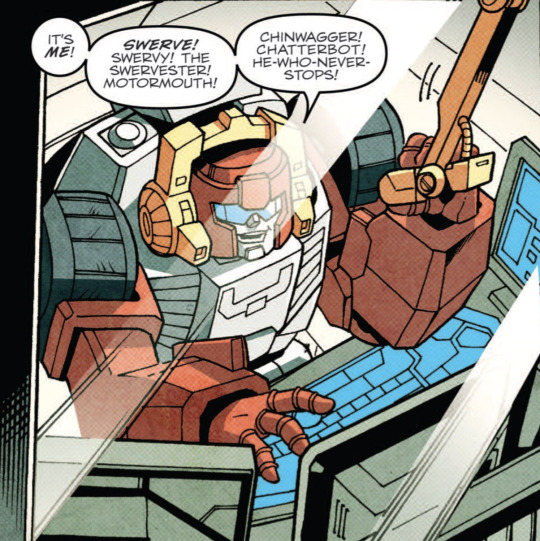
Oh, Guido Guidi, whisk me away to flights of fancy!
Our artist for this issue is none other than Guido Guidi, ascended from fanwork to deliver us from evil with his near-superhuman ability to emulate other artists’ styles and just make things look really pretty. He was responsible for the mythos pages in the 2012 Annual, AKA the best part. He also filled in on some of the art for Last Stand of the Wreckers, not that I really noticed because he’s just that good.
Swerve lets Blurr know that while it might have looked like the Lost Light had exploded, thus killing everyone onboard back in issue #1, that isn’t actually what happened. I’m glad someone filled in the Cybertronian populace on that.
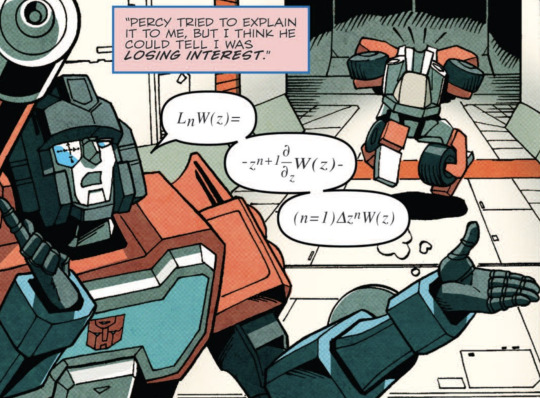
I was never great at math, but those speech bubbles might be phoning it in a bit.
Swerve says that he’s having a great time on the quest, despite all the hiccups, and we get an explanation for why this long-range communications system hasn’t been seen prior to this point. It’s been broken for a while- most likely due to the quantum jump that started the series off with a bang- but Blaster managed to get it running again. Good job, Blaster. With this little setup for our framing device out of the way, we get into the meat of the story.

Swerve is being nosey about things that weren’t any of his business, happening in a closed off room, when Drift drags him down the hall and hid him away for safety. Swerve doesn’t much appreciate being manhandled, but there’s a method to the madness here.
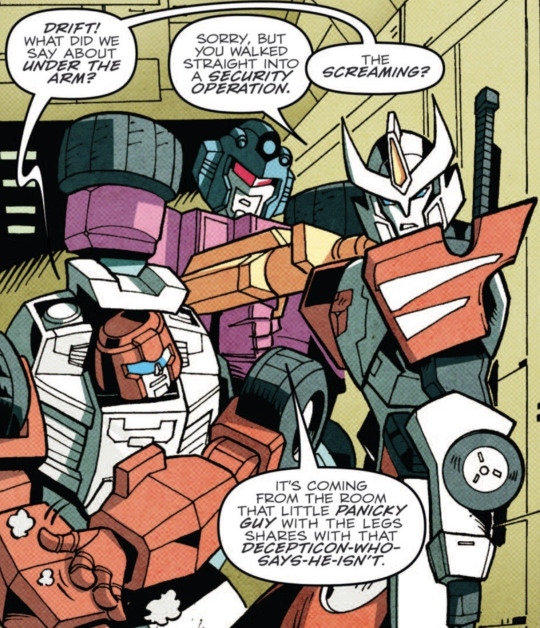
Drift’s nose has vacated the premises once again, so we’re just going to have to deal with that. And how shapely does one have to be to be known as “the guy with the legs”? I mean, Drift is RIGHT THERE.
Drift uses his own powerful legs to kick down the door to Cyclonus and Tailgate’s room. It turns out that the horrific screaming wasn’t the sound of a murder or sexual relations taking place, but rather that of Cyclonus singing in Old Cybertronian.
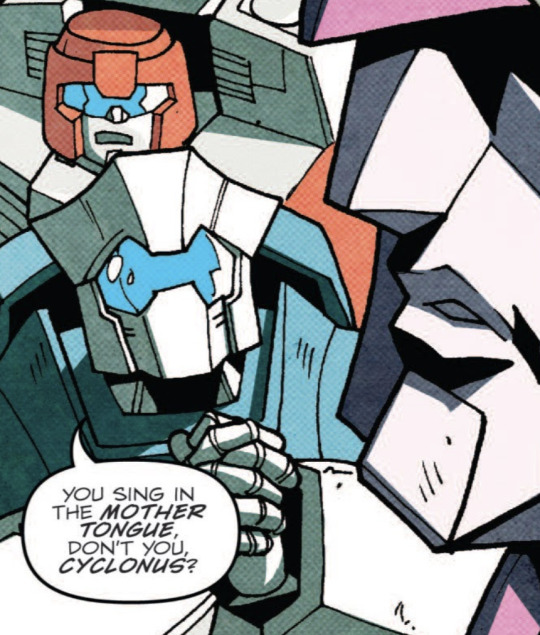
My god, he’s completely enamored with this unrepentant murder machine.
We are just all up in Cyclonus’ grill for this panel. Nothing but lips. Was this specified in the script? Because it feels like it might have been specified in the script.
Old Cybertronian, or the Primal Vernacular as some might call it, was last seen in general when Rodimus channeled the will of the trapped Titan all across Tailgate’s chest. It was last seen spoken when we met Vos, the terrible murder gremlin who turns into a gun and uses his face to cause puncture trauma.
Comic books are wild, y’all.
Now that we’ve established that no one’s being killed, Drift goes back to what he was doing earlier, with Swerve deciding to tag along because he’s horrifically lonely. He invites Drift to come room up with him, because I guess if you’re going to sell off your comatose roommate’s bed out from under him, you might as well go for the guy who’s third in command, is probably one of the hottest guys on the ship, and slices people into chunky salsa if they try anything funny.
Drift politely declines, and awkwardly removes himself from the conversation when Swerve doesn’t take the hint, returning to his sword lesson with Rodimus.

Oh thank god, the obnoxiously pink room is back.
Ultra Magnus bursts into the room, appalled by the actions of his fellow crew members. Some of his concerns are well-placed. Others, well…
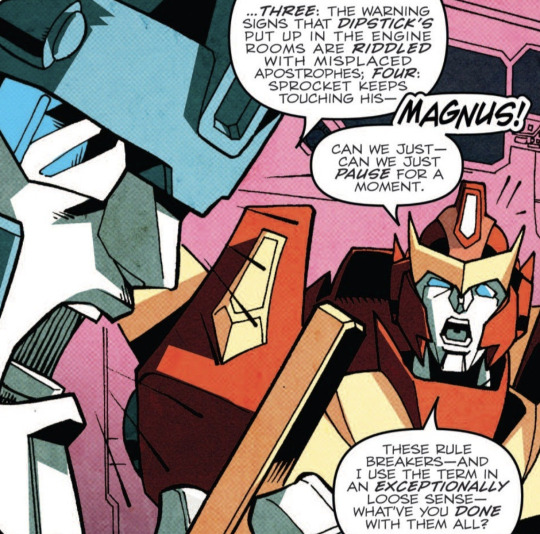
Is- is that another friggin’ retainer on those lower teeth? Why does this design choice keep showing up?
So Magnus has imprisoned roughly a third of the ship at this point, and Rodimus suggests he take a chill pill. Magnus doesn’t even know what a chill pill even is, so we’re forced to make use of our most dangerous weapon- the threat of a good time, courtesy of Swerve.
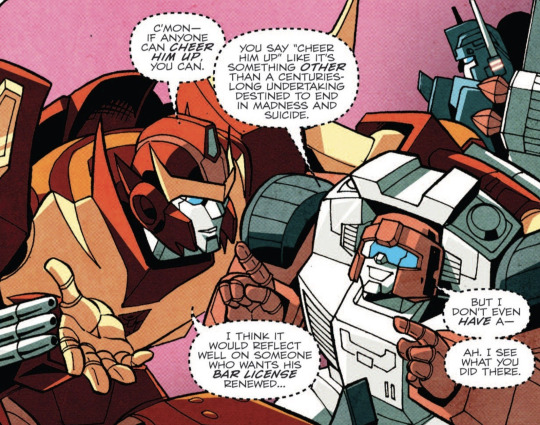
The fact that Ultra Magnus hasn’t reduced Swerve to an oil stain on the floor is genuinely astounding. The guy has zero respect for bureaucracy or proper business management. It has been MONTHS, you dinky little man, get your act together as a business owner.
Swerve takes the bribe, and soon everyone’s shipping off to Hedonia, where the drinks are plentiful and the women… well, most of the Lost Lighters don’t even know what a woman is, so that aspect doesn’t really come into play. Thanks, Furman.
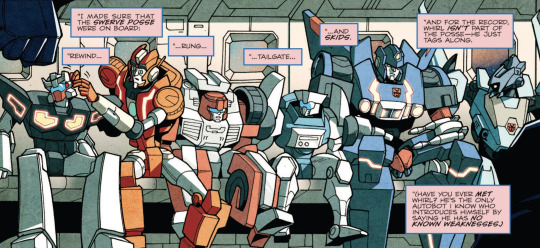
Also, Rung’s back to normal. Don’t worry about it, not a big deal.
Swerve isn’t having much luck on his Roommate Quest, as Tailgate spurns his advances, stating that he’s good kicking it with Cyclonus, mainly because they’re both old as shit.
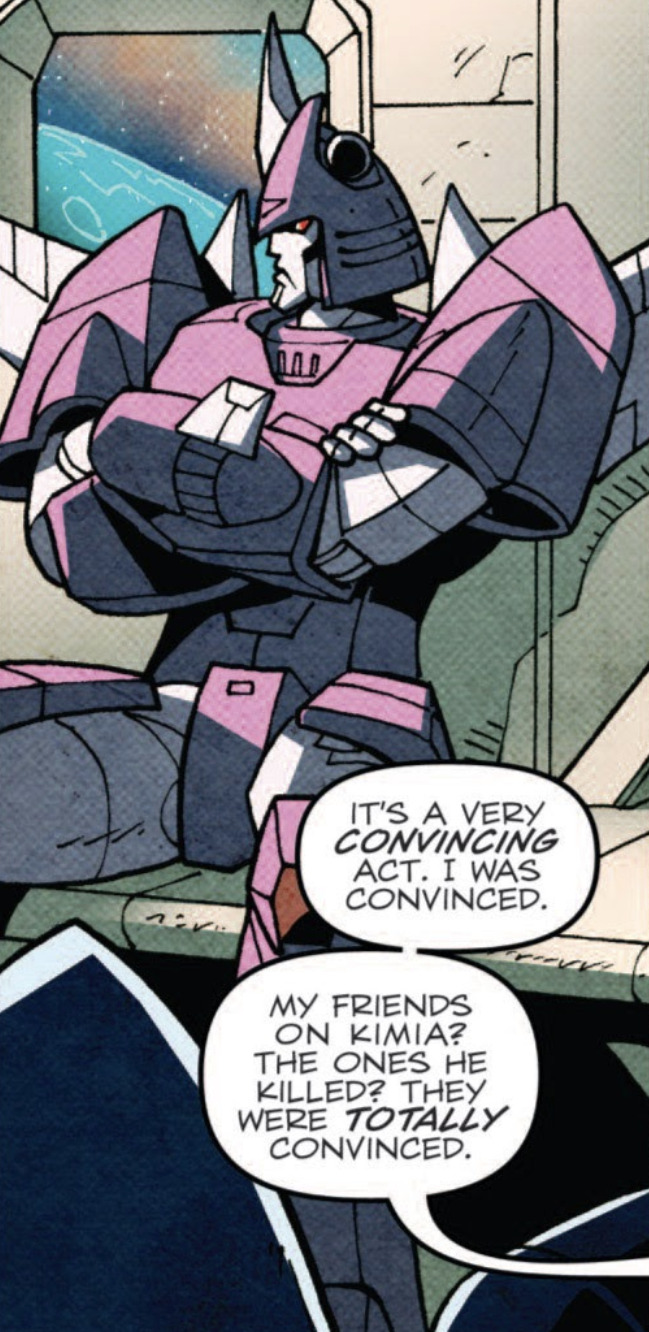
I see we haven’t quite hit the threshold on the “Cyclonus is allowed to have friends now” meter. Give it a few more issues, I’m sure we’ll get there.
Man, zero for two for Swerve on trying to get a hot roommate. Maybe third time’s a charm?
Rodimus pops into the back of the shuttle to remind everyone that their entire race is more or less despised by the entire galaxy, and to play it safe by using their holomatter avatars.
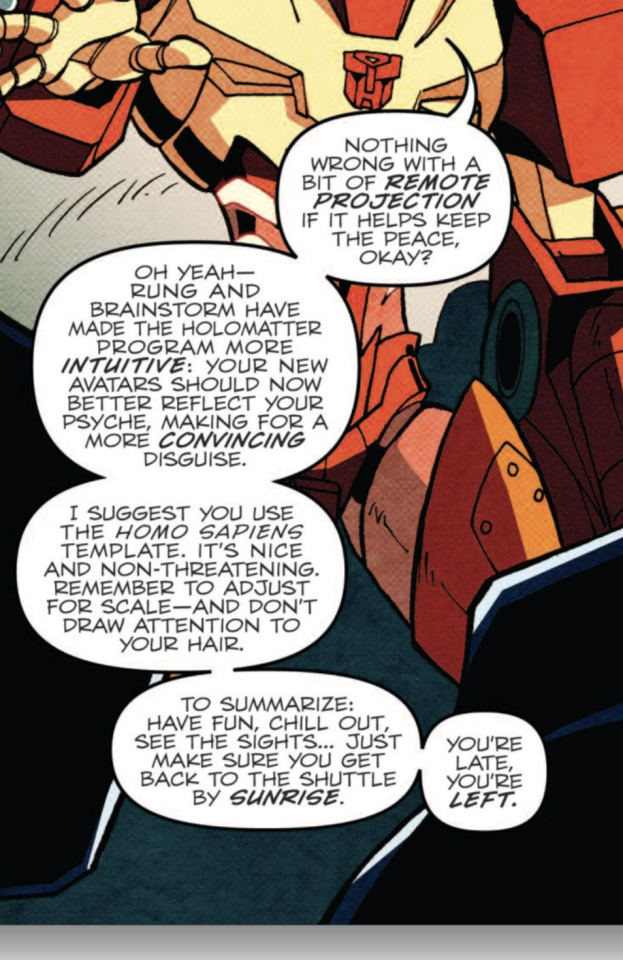
The revamp by Brainstorm and Rung is truly a blessing, because the avatars in IDW were awful to look at up to this point.
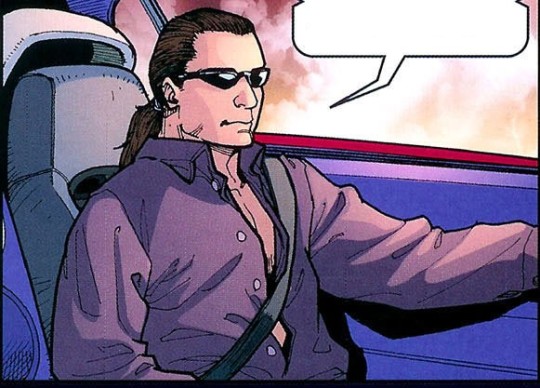
Y’all, that is HOT ROD. Jesus wept.
Getting back to Tailgate’s questionable taste in companionship, Tailgate asks if Swerve and Blurr connected right away. Swerve gives him an affirmative, then starts listing off the guy’s racing stats until Ultra Magnus plops down between the two of them, drawn in by the melodious sound of statistics.
Magnus is having a hard time relaxing, but he’s giving it his best, and I think that’s very commendable of him. It’s hard trying new things.
On the surface of Hedonia, it would appear the B-Movies are having a Pride event in the entertainment district.
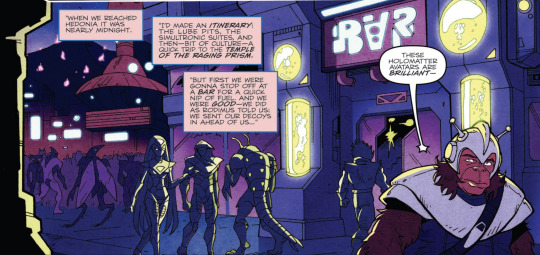
Okay, moment of truth- show us those avatars!
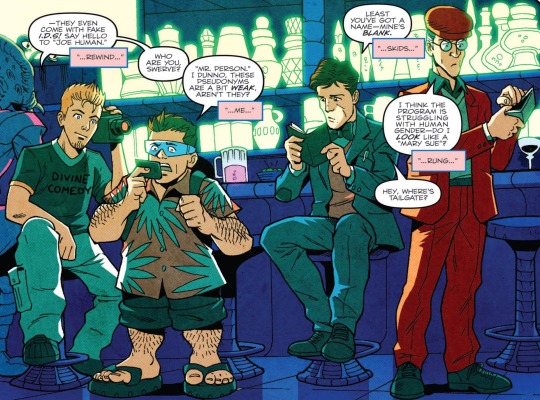
Oh thank god, they aren’t totally hideous. Though, isn’t Rewind old as shit? I guess youth is a state of mind. Still, I can’t believe we missed out on silver fox Rewind.
Rung’s line is in response to folks at the time claiming that Rung was a self-insert character, which is interesting, because we’ve already seen what a self-insert looks like when it’s Roberts doing the inserting, and we’ve also seen his Mary Sues.
Rung, while an original character who had appeared in Roberts’ pre-professional works (a single line of text in Eugenesis, where he was a psychiatry play-on-words), he isn’t what I’d consider a Mary Sue. Mary Sues are usually stunningly beautiful, beloved by their peers, insanely talented in ways that no other character is, and typically have some sort of connection to another character that more or less forces them into the story despite not needing to exist.
Mary Sues don’t get their friggin’ heads exploded, or exist in a constantly-forgettable state. Sure, he’s the only therapist we’ve ever seen in the Transformers franchise, but there was kind of a massive need for that sort of character to be created, seeing as all of these sons of guns have PTSD and clinical depression. And, as we’ve seen in previous issues and will continue to see later on, he’s really not even that great at it.
That isn’t to say that he doesn’t have certain traits befitting such a characterization, merely that they don’t add up to equal that sort of whole by issue #13. Transformers (2009)-era Drift is way closer to a true Mary Sue than Rung is.
Anyway, where the hell did Tailgate get to?
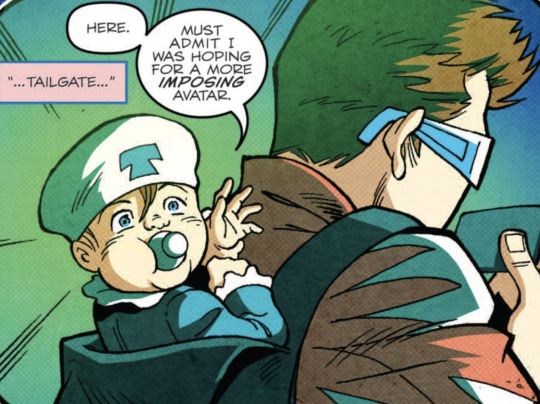
They really just let Frodo Baggins in this bar all babybjörned up, huh? Does Tailgate even know what a baby even is at this point? Does he just think he’s a very small person? How much human media has he consumed? We haven’t gotten into the reproductive process for the continuity yet, but fresh Cybertronians aren’t exactly a one-to-one to human infants. Damn it, Roberts, what the fuck am I supposed to make of Babygate?
Whirl’s off in the corner, disguised as a 12-year old girl who’s fucking STRAPPED. Magnus has disappeared, but Rewind locates him pretty easily as Rung makes a comment about Magnus needing to make an appointment with him.
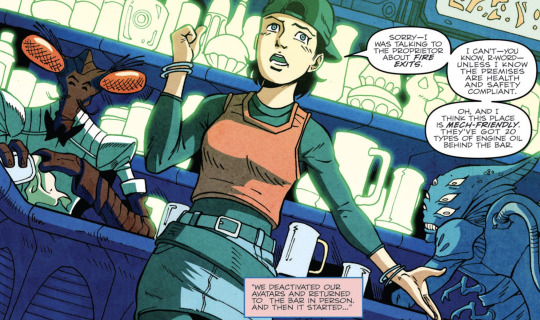
Oh hey, Verity. Been a minute. Careful, ol’ six-eyes over there is leering at you.
The fellas come back to the bar as they truly are, and sit down for a round of drinks. Whirl gets Ultra Magnus a drink that sounds disturbingly like a Cybertronian equivalent to Milk Coke, and we get a little anatomy lesson. Transformers have something called a Fuel Intake Moderation chip, something that keeps them from getting drunk on pretty much the only thing they can consume. Swerve suggests Magnus turn his off so he can have a good time- which I don’t personally agree with, but this is Captain Stick-in-the-Mud we’re talking about here. Magnus gives it a shot.
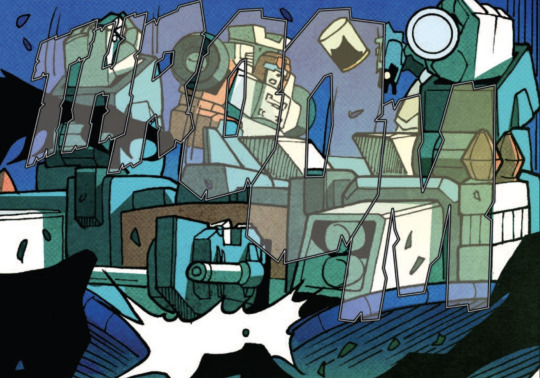
And that’s a series wrap on Ultra Magnus!
No, the man’s just got no tolerance and has been knocked the hell out by his drink. Things begin devolving. Tailgate is crying. Skids has found out that Whirl didn’t give Magnus Milk Coke at all, but instead the equivalent of liquid cocaine. Swerve is convinced he’s going to prison. Rewind is filming the whole thing.
Nobody actually checks to see if Magnus is actually dead, until Rung gets around to it. Swerve, you’re a doctor by original trade, what the hell are you doing?
The boys sit Magnus at the table to wait out his nap. Hours later, nothing’s changed, except that they’ve started up the nemesis game, and Whirl’s decided he’s going to be rude about monoformers being monoformers. Rung gives a non-answer, because that’s just who he is as a person. Skids names Misfire as his worst enemy, only because he’s still missing a good chunk of memory and can’t remember if he had a worst enemy, but still wants to contribute to the conversation.
Rung, don’t be a dick, he did his best. You were right on top of Fort Max, it was a tricky shot.
Ultra Magnus finally starts waking up, and that’s the point where everyone decides to foot Swerve with the bill for the emotional labor he’s going to have to perform by explaining just what the friggity-frack happened.
Magnus starts laughing, then crying, then offloads his troubles onto Swerve. Magnus feels like he just doesn’t fit in on the Lost Light. He’s just trying to do his job and everyone makes fun of him, or disrespects his authority. He’s trying, he really is, but he’s just not built for post-war life. He’s actually tried to leave his position on the Lost Light, but they just keep pulling him back in.
Probably doesn’t help that Rodimus seems more interested in Drift’s opinion on matters than his own SIC half the time.
Oh no, he’s making digs at the things Swerve’s sensitive about. Where is Rung?
Magnus just wants to be understood, y’know? He’s a fully realized creation. He’s got interests. Like music! And the fact that Swerve is missing his Autobot badge!
This was the point where MTMTE was still bouncing back and forth on whether it wanted to commit to the crotch badge. It was a tumultuous time for everyone, very dark days.
WHERE THE FUCK IS RUNG
Magnus, having had enough of sharing his feelings, takes another sip of his cocaine and slips back into unconsciousness. Swerve admits to his limp body that people don’t actually like him, but rather only stick around because of what he can offer- namely, a good time.
The rest of the Swerve posse comes back, with Cyclones having joined the party. Rung shows off his new model ship, which gets Rewind started on his movie collection. He pulls up the opening ceremony for the Ark 1. Y’know, the Ark 1, that ship that Cyclonus was on that disappeared into the Dead Universe for six million years. The Ark 1 that Tailgate was supposed to be on.
Before we can get started however, someone throws the model at Rewind’s head.
That someone is none other than Cyclonus, who proceeds to fly into a rage, throwing tables and shoving the still-unconscious Ultra Magnus to the floor. My word, what a reaction! What could possibly be setting him off so much? Does he not like being reminded of his fated trip to the stars? Is this a manifestation of trauma from that event?
Who knows? No time for questions, Skids is too busy punching him in the face.
Tailgate intervenes, explaining that because Cyclonus and himself are so goddamn old, the engex Cyclonus consumed is wreaking havoc on his body. He tells the rest of them to go on while he tries to calm Cyclonus down. Interesting that Rewind doesn’t have any sort of input on this, given that he is also super fucking old, but there’s no time for questions! We’ve got to get Ultra Magnus back on the shuttle in the next 20 minutes, or else they’ll be stuck on Hedonia FOREVER.
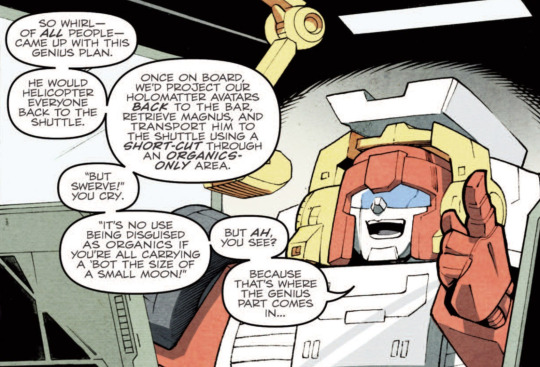
They start throwing Magnus on the floor repeatedly, trying to get his t-cog to spin up. No dice, however.
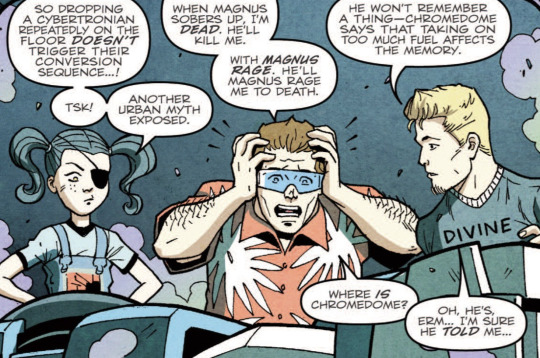
It’s 4AM. Do you know where your Domey is? Because Rewind sure as hell doesn’t.
Okay, time for Plan B.

I’m guessing not, Rung. I’m guessing not.
Using Magnus as a trampoline does the trick, and the boys are rewarded with the sight of Magnus’ alt-mode… resting on its roof, upside down. They get him sorted, pile in the cab- Rewind is driving, which leads me to believe he at least has some experience handling a vehicle. Chromedome does turn into a car…
I don’t even know what that sort of activity implies for a Transformer. We won’t go any further down this line of thought.
The boys manage to get Ultra Magnus to the shuttle in time, and all’s well that ends well!
This is about the time that Blaster knocks on the glass at Swerve to wrap things up, seeing as he’s been at this for over nine hours now. There’s one last little aside before we’re done with our story, however, and it involves just what happened in the bar after everyone else left.
Cyclonus calmed down almost immediately after the rest of the guys left, paying for what he broke and inviting Tailgate to have a seat.
Well, I say invite, but it’s really more of an order.
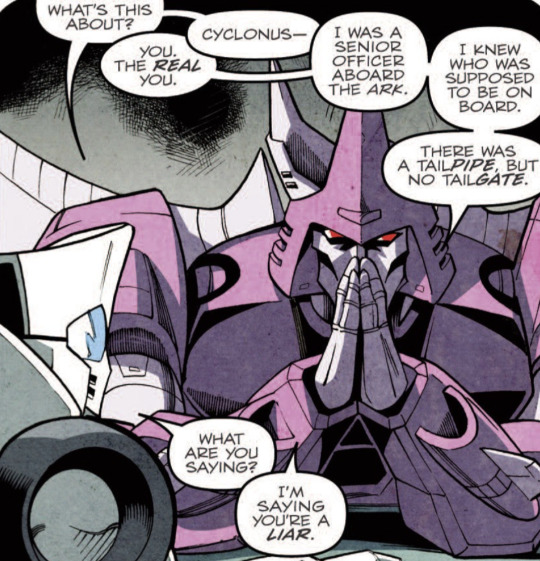
If you’d already figured out at this point that this jumpy little marshmallow was lying about being the biggest badass who ever lived, a gold star for you! It turns out, dear Tailgate has been crafting a fabrication, spinning a yarn, telling a tall tale since Day One on the Lost Light. The story has been feeding us a steady diet of fish the whole time!
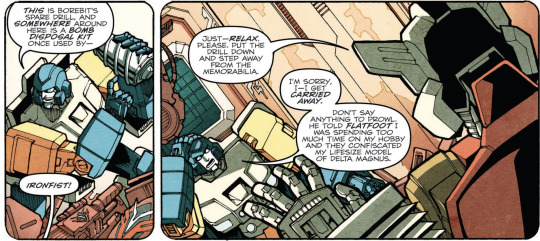
Red herring!

Red herring!
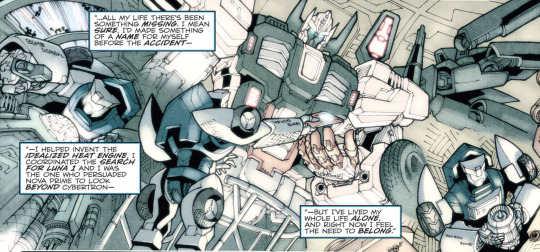
Red herring of Tailgate’s own design! Autopedia’s mods are a friggin’ joke.
Tailgate was supposed to be a the Ark 1 launch, but it was because he was on the cleanup crew. Boy’s a sluicer, and his arm SHOULD say "waste disposal”. Through a cunning use of his wits and cold reading, Tailgate faked his way through the dismantling of the bomb on Temptoria. A smart boy, he is, if not a bit self-centered.
Which brings us to why exactly Cyclonus freaked out in the bar: he wasn’t having an episode, but rather faking a reaction to prevent Tailgate’s lie from being exposed. He still thinks that Tailgate should come clean about this whole thing, before things get really messy, but it wouldn’t be an issue of MTMTE without some raw-ass emotions getting thrown about.
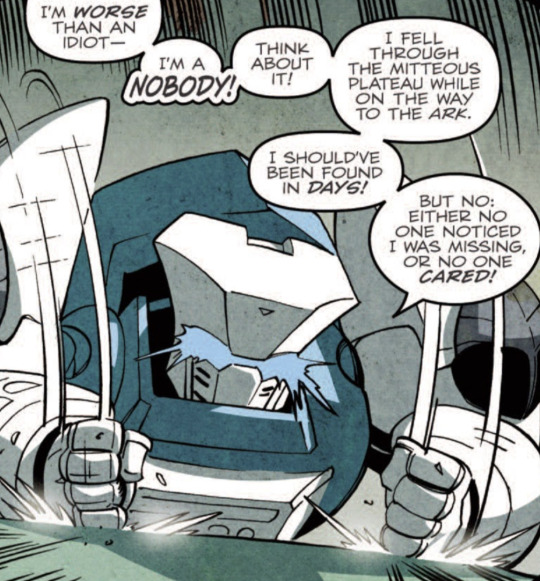
Cyclonus, who hasn’t allowed himself to feel anything other than simmering rage or national pride for over six million years, is beginning to feel something for Tailgate.
That feeling is sympathy, and maybe a little pity.
He offers to teach Tailgate a song to help him feel better, because that’s what he does when he has feelings.
And given that Cyclonus seems to sing often enough that Tailgate’s gotten used to the horrific sound, it might be that Cyclonus has feelings a hell of a lot more often than he lets on.

Roberts, how many times are you going to make Tailgate cry? How much pain are you going to subject him to before you’re satisfied?
The scene closes out on the two of them getting their karaoke on in the empty bar, in the god-awful language that is Old Cybertronian. I can only imagine that they get kicked out of the bar pretty quickly after this.
Getting back to the present, Swerve has finally, finally finished his story, closing out with an invitation for Blurr to come visit Swerve’s.
Blaster gets ready to shoot one hell of a voice message at Blurr, but there’s a problem; the number Swerve has isn’t long enough to be a personal hailing frequency.
Yeah, turns out that Tailgate isn’t the only liar on board the Lost Light.
Four million years ago, Swerve met Blurr at a publicity event, got way too friendly with a celebrity, pestered the guy until he gave him a fake number, and has convinced himself that he made a life-long friend to this very day.
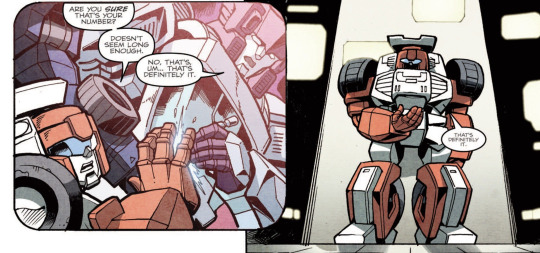
Big oof.
Later, back at Swerve’s, Swerve is busy cleaning the glassware when Ultra Magnus comes in, sober and having just gotten out of surgery to fix his fuel tanks. Guess that second sip of Nucleon really wasn’t a good idea.
Swerve tries to tell a lie about what happened the night before, only to have the dawning horror that Magnus remembered the entire night, as he’s presented with a new badge. Swerve, bolstered by the fact that, while Magnus didn’t enjoy the previous evening, he appreciated having company, begins to ask Magnus if he’d want to room with him.
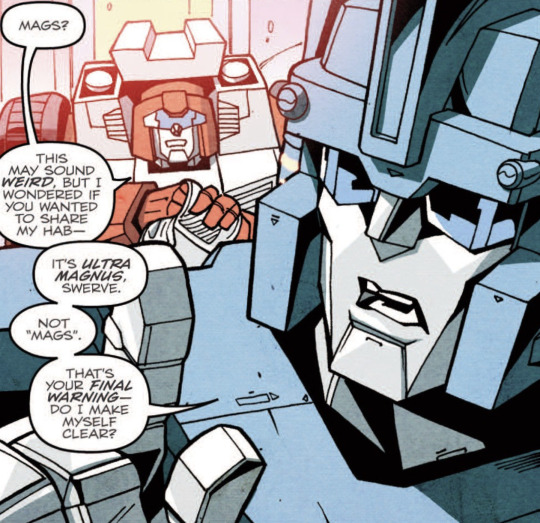
Wow, zero for three! That’s rough, buddy.
Kind of a bummer end to this whole issue, but it was still decently light, tone-wise, for MTMTE. A great deal of fun was had, in between all the mortifying reveals of our characters inner demons.

...Well, shit.
#transformers#jro#mtmte#issue 13#maccadam#Hannzreads#text post#long post#overthinking about robots#incoming analysis#comic script writing
142 notes
·
View notes
Text
The (rather) hideous subtext of How to Train Your Dragon: The Hidden World
The Hidden World- well, a ravine of sorts.
It has completely split up the franchise, into pro(everything in this review) and against (well…ditto).
And there seem to be more of the latter. If that’s you, enjoy this review.
The main reason people gush over this film, are well, a collection of sorts. Animation. Lighting. Moonray- a newly installed DreamWorks technological brand that only recently came into action. Many people were captivated by the Nightlights, by “ooh look at that cute dragon” and whatnot.
The cute dragons and epic vistas of New Berk aren’t bad. It’s what’s under them.
What lies beneath
Cute dragons and fake facades hide what really lies beneath- what this film is all about. Separating Hiccup and Toothless. Many a time have I seen people parrot on about how Toothless found love- it’s okay for him to completely neglect and abandon Hiccup.
Many a time have I seen people go on about how Toothless and his call to the wild supersedes his friendship with Hiccup.
Many a time have I seen people justify the Light fury and make her existence seem glorified- when she exists merely to separate Hiccup and Toothless- that inseparable duo that many- if not most fans- hate to see the separation of.
In essence- people backing up a separation that never should have been. People backing up the complete and utter breakage of a friendship that never should have been broke.
Many billions have by now seen this film- and not all of them are fans. Most of them are passers-by- giving blind praise (to this film) where it is not due.
I am not saying this film doesn’t deserve praise. Sure- the animation is fabulous. The lighting and SFX/VFX is superb. There are many things about the Hidden World that I like. None of them are to do with the plot, the way they handled the separation, the mere notion of separating Hiccup and Toothless permanently.
I don’t mind a separation.
And- by the way- I mean one which doesn’t involve the type we got in HTTYD: THW, what with Hiccup and Toothless growing apart, living alone and whatnot. I mean one like Gift of the night fury- where Toothless came back to Hiccup. Where we, as an audience, return full circle, with the affirmation that Hiccup and Toothless are indeed inseparable.
One which confirms a true friendship. Not what THW gave us. Though, I will give them credit for trying in the epilogue scene.
I am not saying this film doesn’t deserve praise.
I am saying, however, it makes a train wreck of the friendship between the central duo of this franchise.
Many people say that the Hidden World is great and satisfying (really...?) because Toothless goes back to the wild… he belongs there… he needs to leave Hiccup as finding a FAMILY is what brings him happiness.
Not Hiccup. Hiccup used to give him happiness, love, affection and companionship- he still does- but NONE of that matters to Toothless- supposedly- when the Light Fury enters the game.
No, just no. You give me proof of Toothless behaving like this- once- even in the previous instalments- and I will give you the previous instalments.
The facts are there. Toothless’ family is Hiccup. That has already been established- from every single other piece of media in this franchise.
Since when has anything mattered more to toothless than that one boy who, being the only one in his entire village, alone, neglected and saddened, tried to give dragons and humans a second chance? This boy was known to be Hiccup- he changed history with Toothless. He ended a war between two disparate species- he gave this dragon, who we call Toothless, more love and affection than anyone else at the time would even dream of.
He gave this dragon his flight back- but the dragon gives him friendship back.
Hiccup has practically raised this dragon for years of his life. Years he could have spent being barbaric, killing dragons, fighting… no. Hiccup has fed Toothless, bantered with him, played with him, bathed him, attended to wounds/injuries.
Just like you would your own pet- but Toothless isn’t a pet. He was the first to believe in Hiccup and really bond with him- more than anyone else at that time. If you don’t recall- at the time when Toothless and Hiccup first met in the Cove, Hiccup was laughed at, taunted, bullied and neglected by his father and peers around him.
Only a member of the opposite species gave him actual companionship. First.
Which is why is why it really gets to me when Astrid says-
‘But you know what? I was the first to believe in you’- making it seem as if she was the first to instill confidence in Hiccup. First human? Sure. First sentient being? Nope.
Ironic as at the time Toothless was the only creature offering him companionship.
The friendship between Hiccup and toothless- plus more
What has this franchise been about? What is it been centered around for as long as we can remember? The friendship- the bond between hiccup and toothless. It has always been about how they are inseparable- and also, every single movie, episode and short film- excluding the Hidden World-, every single race to the edge hicctooth moment brings them closer together. It strengthens their resolve.
They are the best of buddies. So, what does How to Train Your dragon- The Hidden World achieve? It breaks that bond. Why? For the sake of romance!
Romance.
Toothless- having been with Hiccup and fought alongside him for years- and having a virtually unbreakable connection with him that can never be broken- suddenly dejects Hiccup and is not only torn away from him, but is almost desperate to leave him? Where is his loyalty to him? Where is this ‘friendship of a lifetime’ we were promised? The entire film sets the premise that Toothless realises he doesn’t need hiccup and that his real destiny is with the light fury- as Hiccup, his best friend that is with him for years- means little. How can we- as fans- accept this? Most of you reading this won’t, I’m sure.
The separation, gift of the night fury and freedom
“So that we could get to that moment like the opening narration of Cressida Cowell’s first book. There were dragons when I was a boy. I thought there was something really emotional about that. But it suggests the end of an era.”
Nothing wrong with this. This could work in any other franchise. Not HTTYD. The disappearance of an entire species seems apocalyptic- right up my street in fact- but wait a minute. The dragons and the berkians are meant to CO-EXIST… right? They are meant to find a way, or ways to work together. They do. They develop a perfect state of friendly peace between the two species- until THW. Hiccup gives up his resolve- that him and Toothless- him and toothless- have been working on.
A perfect state of peace.
And Hiccup says- I was so busy fighting for a world I wanted- wait… ,’I wanted’ ?
(Hiccup and Astrid, both smiling, nod at each other and press their heads together. Toothless, after walking past the Light Fury, looks at Hiccup, who smiles at him. Toothless looks towards the horizon and back to Hiccup again. Hiccup also looks at the horizon and back to Toothless. He then hops to Toothless and holds his face.)
Hiccup: You're right, bud. It's time. I was so busy fighting for a world that I wanted, I didn't think about what you needed.
Hiccup and Toothless have been working together- as one- from the beginning- and this movie ignores that and makes Hiccup seem outright selfish as he didn’t think about what Toothless needed? Toothless has outright stated prior he doesn’t need anyone else but Hiccup. In fact, Toothless wants peace and coexistence between humans and dragons. Wasn’t that one of the reasons they bonded?
For reference, see Riders of Berk- in one episode, Astrid (ironically, being the same Astrid in 3 who claims Toothless has been given his freedom, so will never return) claims Toothless is happy with Hiccup and doesn’t need anyone else. Not a bad message. Many people only have one friend and are fine with them. In fact, it isn’t how many you have, but the quality (but that’s a different topic)
This movie?
Abandon your best friend for the sake of a partner.
Hiccup is everything to Toothless- and vice versa. These two have such an unbreakable connection. Where has it gone, movie?
Good movies come from character growth- character evolution. They don’t come from devolution and a complete reversal of growth of said character.
Also- something else. About halfway into the movie, after returning from the failed mission to raid Grimmel’s base- several key lines are spoken by two main characters.
Hiccup says ‘toothless and I will-‘. He’s cut off. Hiccup at this point fully expects toothless to return- again, not because he is keeping him captive (expanded on later)- but out of love, loyalty, companionship. They’re best friends, right?
Isn’t that how it’s always been?
And then- the two lines which are simply infuriating- “you gave him his freedom” and “he has the light fury now”.
Both these lines strongly imply Toothless doesn’t want or need Hiccup. As does the scene in THW where Toothless has “found his place amongst dragons, realising his true destiny”- quote from Dean D.B.
Without all the extra glorification- realising he doesn’t need Hiccup when Hiccup is the reason he is alive- the single person on the planet who cares for him the most. Gone.
In two days.
And doesn’t “he has the light fury now?” completely deject their bond?
As if to say- he doesn’t need you- his best friend who he supposedly cares about.
So many lines- plot points- utter rubbish- solely designed to tear these two apart for no logical, justified reason.
Also, let’s talk about freedom. A strong aspect when considering this concept is the call of the wild.
A call of the wild refers to an animal, kept in captivity, isolated from the rest of nature, wanting to be free.
Remember gift of the night fury?
Toothless was given his freedom then. Surely, if he was experiencing this call of the wild it would build up over time- not just be a sharp ‘I want to leave Hiccup’
He would have left in gift of the night fury. But no- he destroyed the automatic tailfin because flying with Hiccup, as one, as two best friends bonded by their shortcomings.
As you can see, this call of the wild arc introduced in HTTYD 3 completely disintegrates the bond that Toothless chose, chose.
Toothless was not forced into captivity but instead out of compassion and love for Hiccup made the decision to live with him. How is suddenly sending him back to the wild- and according to the directors- because he chooses another dragon over Hiccup- a deepening of his arc?
It doesn’t deepen it- it’s trying to dam a river that supplies water to millions of people.
It doesn’t end there. Toothless, when leaving is described as ‘hesitant, conflicted’
Conflicted?
Conflicted over the same Hiccup whom he shares an unbreakable bond with? The same one whom he wouldn’t leave for the world? And that too- conflicted over a female- over another dragon.
Conflicted to even think about leaving his best friend. Years of friendship- gone, replaced with the message “romance supersedes friendship”
So much for the friendship of a lifetime.
Furthermore- the crescendo that plays during the separation is called Freedom. The original FYC OST is titled that.
Freedom? From what? Freedom implies a release from captivity for an animal that was being kept captive- in a poor mental and physical state. In essence- the dragons were being used as slaves- or tools, kept against their will involuntarily.
Hiccup was keeping Toothless a slave.
This is an utter abomination to both their friendship and the Berkian dragons.
They have relationships. They are there because they want to be there- because they enjoy human companionship. The artbook(s) even say as much- along with the script. Remember Hiccup’s line- “now they’ve all moved in. And really- why wouldn’t they?” The berkians adapted their own lifestyle to accommodate these animals. The animals-dragons- are there out of free will.
Free will. The complete anthesis to slavery and subjugation.
Let’s look at three examples.
Remember this scene? Hiccup says ‘we built custom stables, all you can eat feeding stations, a full-service dragon wash”
Basically- they love these creatures and care for their every need. Far from keeping them slaves- as implied by freedom- when slaves or workers in our own world are kept in uncomfortable conditions. These dragons, and Toothless himself, are far from uncomfortable.
They even bathe them and wash them- as you would care for your own pet. Hiccup even takes the time to bathe Toothless himself as we see below. And giving him a chin scratch.

All the time- showing Toothless affection and companionship. Important to note that without Hiccup, Toothless would be non-existent (for a euphemistic word), in Grimmel’s trophy cabinet. And Hiccup isn’t just best friends with him- he actually cares for this dragon.
Doesn’t that indicate the dragons moved in because the Berkians became compassionate? Compassionate thanks to, and spread by, Hiccup?
Isn’t that what this series is all about? Mutual coexistence?
Also- look at this.

Toothless came back to Hiccup out of love for him, out of genuine compassion. I mean- look at that face. Definitely being held “captive” right? Captive by Drago- yes, but you see, this is what the franchise- at least 1 and 2- try to defy. That friendship can overpower anything.
Especially the friendship between Hiccup and Toothless.
And Hiccup didn’t go back to Toothless so he could win back Berk. That wasn’t his main motive. He went back because he loves him. Too much- in fact- to even repent yelling at him afterwards- when he screams “Toothless!” after he is taken by Drago.
Moments after killing his father. So much for “slavery”. You can visualise and make out Hiccup’s emotion when Toothless comes back. Remember what he says? “Attaboy, that’s it!”
Isn’t that genuine friendship?
Look at how happy he is just to see Hiccup. Absolutely heart-warming- and look at where HTTYD 3 puts it.
Again. I don’t really know what to say. How are these adorable creatures being held captive? Look at him- clearly enjoying the belly rub.

What a farce. Honestly.
Envoi- final thoughts
To cap this off, let’s look at Maslow’s hierarchy of needs.

Let’s look at this. Motifs near the base of the pyramid are significantly more important that those at top.
In Gift of the Night fury- Toothless rejects autonomous control for his friendship with Hiccup. Toothless inverts the pyramid. Looking at the pyramid, Toothless thinks “love and belonging” is more important than “physiological needs”. Why?
Because one (of the many) reasons Toothless and Hiccup are inseparable is that they are bonded over their shortcomings. And it is these shortcomings, which, mutualistically, they realise are anything but. They make them stronger.
In essence- he puts Hiccup first- then himself. Note- Toothless made this choice. Wasn’t forced, wasn’t subjugated. He chose to do this.
The third instalment, supposedly markets this too, if we go by the trailer which conjures up a big “Friendship of a lifetime” logo on the screen. That really hyped me up. That was what- I- and so many of us- most fans- wanted- the GOTNF style affirmation that Hiccup and Toothless are indeed inseparable- despite all the terrors that strike their village.
I sold myself (as I am sure many of us viewers did) on this.
Now I wish I hadn’t.
The third movie makes Toothless put his “so called freedom” first, before Hiccup- before friendship. A complete reversal of the picture we have seen in the previous instalments.
We see that, according to Maslow, freedom is a lesser, baser need than friendship.
I sold myself on this.
Now I wish I hadn’t.
5 notes
·
View notes
Text
When It All Goes South: A Designer’s Nightmare
Back in 2013 a client named “Nicole” contacted me. She had been searching for a designer to work with for several years and wasn’t satisfied with the “talent” she had found thus far. She stumbled across my website, found my contact information and gave me a call. She had a stash of fabrics and some basic ideas and we spoke on the phone at length . . . A conversation that lasted over an hour.
I had been a seamstress since I was a pre-teen. My grandmother began teaching me to sew when I was a child and I sort of “fell” into historical costuming by happenstance in 2001. That happenstance being my 16 year old daughter wanting to join RenFaire with her friends and had to have a parent join with her. I used my experience as a seamstress and began dabbling in historical clothing. I made our garb and it was “passable” - barely! LOL Of course I’m judging myself by my current abilities, but hey...we all start somewhere.
Fast forward to 2012. My husband had died from on-the-job injuries sustained in his position as a law enforcement officer and the kids and I relocated to Bonney Lake, Washington. My husband’s death provided me and my adult kids with a generous retirement, so when we relocated to Washington State I was fortunate enough to retire as a Medical Transcriptionist and pursue my costuming full-time.
Enter “Nicole.”
One of my biggest faults, if you can classify it as a fault, is that I am generous. Generous with my time. Generous with my talent. Generous with my friendship. And generous with my trust. This generosity gets me in trouble. It has for my entire adult life, and more especially since taking my talents public and opening my website and Etsy store. But it also has affected my personal relationships. I am a Leo. Astrology likes to paint us Leos with broad strokes. So, for the record, I’m not the attention seeking, spotlight loving, glory hog people may associate with being Leo, but I have a big old fluffy lion heart and I’m driven.
Another factoid: I’m very intuitive. I won’t go into the “I see dead people” stories or the dreams that come true. That’s a story for another time. I’ve used that intuition as a designer. In most cases I can tune in with my clients and get a real ‘read’ on their tastes and have pulled off some pretty awesome costumes as a result. It’s why I like it when a client gives me the freedom to follow my creative inspiration rather than constrict me to follow “their” vision to the exclusion of my creative input. That’s the one time I will own my Leo-ness. I work best when I can take the lead as a designer, but I’m VERY sensitive to my client’s input. So my process is usually a 60/40 mix.
After that long conversation, I didn’t hear back from Nicole until 2016. She’d relocated from New York to California and was now “ready” to proceed with a gown commission. Great! She sent me a huge box of fabrics and trims she had been collecting for over a decade. She had some great fabrics that I was itching to get my hands on, but she wanted her first commission to be made out of a blue “patterned” upholstery weight velvet she had in her stash. Not my recommendation to use upholstery weight velvet, but I will make do with what my client’s have - unless it’s simply too hideous or won’t drape properly.
I sketched out the gown she communicated she wanted, and pitched my ideas for embroidery, sleeves, and such. I took her deposit and when her reservation rolled around I began working. As I was in the process of embroidering the gown pieces, she called and pitched me the idea of me using a reproduction of an Elizabethan embroidery pattern used on waistcoats of that time period. She wanted her forepart “completely” filled with that pattern. I gulped, and agreed - even though I knew it would be extremely time consuming. Now, mind you - - If I charged FULL PRICE for such a piece, using the standard fee scale for commercial embroiderers, it would have cost in the range of about $1000 or more! But, I was more concerned with making “her” vision a reality and enjoying the creative process and I DIDN’T CHARGE HER extra! (Oh my god, what the hell was I thinking?). There’s that generosity getting in my own way again.
We had continued to communicate over a period of time even after her commission was complete because I “thought” we had built a friendship. We had quite a lot in common - aside from our love of costume and RenFaire. What I was to learn later (at the beginning of 2019) was that she was my friend so long as she was getting something out of that relationship. Stay tuned, I’ll get there in the telling of this story.
So, I designed the blue gown you see in the link at the end of this page and shipped it to her. She was ecstatic with my work and immediately we began planning a “peacock” themed gown. As part of my process as a designer, I generally ask my clients to send me three pictures of their favorite gowns they’ve seen. There were no pictures she could send me for “reference” as this was her dream gown. I sketched out a gown, incorporating designs from a picture I had seen, and she LOVED IT. The only issue was the embroidery pattern. Did she want this Elizabethan style gown to be more “literal” in theme with peacock feathers and a full peacock, or just “touches” of a peacock theme such as the color of the gown. So, I began to scour the internet and vendors for anything to do with Peacocks.
While I strive for authenticity in the cut of my design, my challenge as a designer is to meld the "historical purist" with my client's vision or "fantasy" and produce beautiful and functional ensembles that hit as many points as possible; and offer the public a vignette into each respective time period. While I adore projects that strive for more historical accuracy, what's more important to me as a designer is pleasing my clients, working within their budget, and encouraging their love and knowledge of clothing from bygone eras. So, while peacocks were not a historical theme for the 16th Century, I was game.
The gown went through several iterations in terms of embroidery patterns. Whenever I thought we had nailed down a concept (for the embroidery), she would call me or send me pictures and pitch more ideas for this gown. I’m always open to my client’s input, but the process just kept going...and going...until finally we had reached the date of her reservation! She hadn’t even purchased her fabrics yet! The fabrics were actually the easiest part of the process. We knew what colors we were to use but she hadn’t purchased the yardage we had discussed. With time running short, and the fact that I generally have a very full commission schedule on my calendar, I rescheduled her peacock gown to my next available opening and pitched the idea of using some of her other fabrics and use the time I had to design something else. (See the Red Pomegranate Gown in the link at the bottom of the page). That brought us to about April of 2018.
Over the ensuing months, we continued to discuss the peacock themed gown and she could not settle on an embroidery pattern. I kept sketching, and keeping notes on her feedback, and searching for patterns that might work. She finally came to the decision that she didn’t want it to be too “literal” with peacock feathers AND a peacock portrait - which she had decided that’s what she wanted (a portrait). So, I began researching and sent her pattern after pattern after pattern. She finally came to a decision, and I breathed a sigh of relief. We had discussed this damn gown ad nauseam and I was ready to just get on with actually building it rather than to talk it to death.
With a final concept in mind - or so I thought - she went to the website where I purchase my silks and attempted to order the fabric in the colors we had previously chosen. However, the fabric we were planning to use was now out of stock. So, the gown was postponed ONCE AGAIN.
It was going to be some time before the fabric we had chosen would be in stock again, and because of that delay I had to give her reservation away to another client. I mean, this IS my bread and butter! And I had broken a hard and fast rule and hadn’t asked her for a deposit. How the hell could I when she kept changing the damn gown! I charge by the pattern piece - Every piece I physically sew together, but the embroidery is factored into my estimates. The intricacy of the embroidery would affect my fees, so I couldn’t really nail down an exact number - other than the basic estimate I had worked up months earlier.
In the meantime, she had more fabric waiting to be used and I had an concept I thought would be beautiful: pairing a pale gold and cream damask brocade with a blueish-lavender silk and embroidering it with blackberries. I had my digital artist digitize the patterns: realistic looking blackberry clusters with multicolored leaves and glass beads to create the actual berries. So, when her reservation date arrived ONCE AGAIN, I was all set to start the embroidery process. But wait! NOW, she decided at the last minute that she already had a gold colored gown she had purchased years ago, and she really wanted to revisit the peacock gown. So, once again, we were back to discussing embroidery.
She kept pitching me wild ideas such as a peacock head and body on the bodice stomacher with the tail extending into the forepart. Huh?? Is this an Elizabethan gown or a Charles Worth gown? I mean, come on! I’m good but that wasn’t an idea that would translate into an actual finished gown, at least not an Elizabethan style gown. So, following her EXPRESSED desire not to over do the peacock theme I found a pattern that was beautiful and suggested we use it on the stomacher of the bodice and a mirror image at the bottom of her forepart. I sketched up the concept, and found a beautiful filigree embroidery pattern for the skirt facings - a style SHE had suggested. She had previously expressed she didn’t want to over do the peacock theme by adding peacock feathers, but now, once again, she was changing her mind. Now she DID want peacock feathers on the forepart and sleeves. OK! We’re making some headway - so I thought.
She was in a car accident and suffered a head trauma. It wasn’t serious but it rang her bell pretty good but she had to have major dental work as a result, and then her son had to have surgery and she postponed the gown due to financial constraints.
When she was ready, we picked up where we left off a few months prior. With the main “peacock” for the bodice front chosen (or so I thought) I waited for her to send me her fabrics. I waited - and waited - and waited. Come to find out, the dye lot of the color she had chosen for the main color of her gown was MUCH different from the original swatch and she HATED the new color. So, now we were back to purchasing ALL NEW fabric swatches and deciding on what colors to use. FINALLY, after weeks of debate and more phone conversations, she decided on her colors. So, she purchased her fabric, and we were all set to proceed - so I thought.
It had been several months since we had discussed her final embroidery choices, so with her swatches and my sketch I created a design board showing all the concepts, colors, embroidery patterns, etc., that she had agreed to use. I then told her in order to proceed I would need her deposit. Now, keep in mind, I’d lost thousands of dollars already by giving her multiple reservations - turning away multiple commission requests in order to accommodate her. But she was my friend....right?
After receiving my design board she decided she did’t like the embroidery pattern that SHE HAD AGREED TO USE months earlier, and was now back to searching for a better peacock. I took a deep breath, and I drew on my professionalism, and said, “Ok. . . You tell me what you want to use.” She then sent me a drawing she had done years before - which she previously nixed because she had decided against peacock feathers and a peacock portrait! ARRRGHHHH! You feel my frustration yet?
During these two years my brother - my ONLY brother - fell ill. He was a renowned physician who was revolutionizing orthopedic medicine using stem cells to regrow cartilage and other ground breaking treatments that were changing lives. He traveled all over the world teaching, and treating patients, as well as keeping a full patient load in his Bellevue, Washington practice. He kept his diagnosis secret - even from me. Turns out, he had pancreatic cancer.
Approaching January 2019 he had lost so much weight he was flesh draped over skeleton. I knew he was sick. I knew it was serious. My intuition kept telling me it was pancreatic cancer, though he had not confirmed my suspicions. I’d watched our grandmother succumb to the same disease. But stubborn man that he was, and dedicated to healing people, he refused to accept his mortality. He suffered two years WITHOUT PAIN MEDS in order to be able to legally treat his patients. Can you imagine? He would writhe in pain, screaming while his daughter held his hand all night, then get up in the morning and treat patients - lying down in between appointments just to make it through the day. That was dedication! That is the kind of integrity he had. That was my beautiful brother. I like to count myself cut from the same cloth in terms of work ethic, but I pale in comparison to this man. He was a genius. I’m not fricking exaggerating out of familial bias. He wasn’t content just to understand bio-mechanics and the physiology relating to orthopedics. He wanted to understand the whole body - and he DID. He was hands down the BEST diagnostician I had ever seen in my 20 years working for multiple doctors as a transcriptionist.
Towards the end of January 2019, he called me and asked the kids and I to gather together so he could talk to us. “I have pancreatic cancer.” He admitted, “But I’m not giving up!” He rattled off the treatments he was still trying, and apologized when I began to cry. I cried like I hadn’t cried since my husband died. Three days later, we got a call from my niece telling us he was in the hospital and we’d better hurry. I sat by my brother’s bedside for about 12 hours - along with his wife, son, daughter, my kids, and a select few family and friends - and watched him slip away. That brilliant mind that had saved so many lives was riddled with toxins and infection and he was now septic. He kept shaking his head, trying to clear the fog that infected his brain - all the while stating, “I think I can beat this!” He passed away that night around 10 pm. And I was now alone in this world without my brother.
Over the following couple of days, my assistant, Lalana, began fielding all my calls and commission requests. I was numb with grief. I worked just to keep from collapsing in on myself but I wasn’t functioning very well. My brother was the only sibling I had left in my life. His death took me back to the day my husband died, and it was all I could do to keep moving. We come from sturdy Scottish stock. My grandparents were farmers, and southerners who had survived the depression. I’m tough, but I know when to say “Uncle.”
To others I looked like I was functioning fine. But inside, i was hanging on by a gossamer thread so when Nicole contacted me TWO DAYS after he died and left a voice message about wanting to discuss her Peacock gown, I wanted to just run away and hide. I sent her a text message and explained to her that my brother had just died and that I was in a very bad place. She being a therapist I thought she would understand and could empathize. Instead, she said “I just need ten minutes of your time.” I read the text, took a deep breath and reiterated that I had just WATCHED my brother die and that I was depressed and grieving and that I couldn’t discuss her gown right now. I asked her to give me a couple of weeks to right myself and we’d pick it back up then. She’s a THERAPIST she’ll understand and respect that boundary, won’t she? - I was wrong.
Over the following two days, she continued to insist that she just needed ten minutes of my time, just TEN MINUTES and couldn’t understand why I wouldn’t talk to her. I gaped as i read her messages. “Jesus Christ, why isn’t she getting it?” I thought. I took a deep breath, and tried again, this time a bit more strongly. I told her I was grieving, I was sad, I was depressed, I was crying intermittently, and that I simply didn’t have the energy to discuss her gown RIGHT NOW. Surely, that will get the message across? NOPE. She continued to harass me, stating she just needed to talk to me on the phone for ten minutes and then she would leave me alone to grieve. WTAF?
I tried again to assert my boundary, clinging to my professionalism, but mostly trying to salvage what I thought was a meaningful friendship. I repeated that I wasn’t going to talk to her on the phone but if she wanted to send me a message by Marco Polo I would listen to it when I felt a bit better. NO! She insisted I discuss her peacock gown on the phone as she didn’t communicate well in text messages or emails, but that she just needed ten minutes. Reality? There has NEVER been an occasion where this women only talked for ten damn minutes! I knew that! - And I wasn’t going to give in to her bullying. Once more, I wrote back that I could not talk to her about her gown, that it was the farthest thing from my mind at the moment. That’s when she did a 180% turn and I realized this woman is not my friend. A friend wouldn’t DARE ask me to set aside my grief to hear her ideas for a gown that had been DISCUSSED ad nauseam. She fired back in a vicious diatribe during which she claimed that she NEVER agreed to the embroidery pattern that I had used in my design board and that I was being unreasonable. “I” was being unreasonable? Are you frigging kidding me?
The more she pushed, and bullied, and accused, and attacked, the more I stood my ground and she went NUTS! I realized then that I was dealing with a true narcissist. I’d been raised by a malignant narcissist so I knew what I was dealing with now that her sheets had been pulled. What shocked me out of my socks was that she was a THERAPIST? My god!!! How insensitive and selfish can you be? It wasn’t bad enough that I just lost my beautiful brother, but I was also facing the reality that the person I had confided some of my darkest, most painful moments - someone I thought was a friend - turned out to be using me. So long as she got her way, we were great pals. The SECOND she didn’t get her way she turned VICIOUS and turned on me. At that realization, I invited her to find another designer and that it was clear to me that we weren’t friends after all.
She continued to harass me and sunk to passive aggressive comments such as “I thought we were friends,” stooping so low as to contact another designer who had made her a Victorian gown (which she complained to me about in regard to the quality of her work) and proceeded to trash talk me to this woman. I know because she accidentally shared the conversation with me on Facebook messenger thinking I was this other woman. I got to see who she REALLY WAS - and yes, I called her out on it.
Did I mention how much I abhor drama?
She went on the Elizabethan Costuming page and posted a picture of the blue gown I made her and claimed it was “her design.” She stated that her previous designer had retired due to “arthritis” and that she was looking for a new designer to work with her. Pictures of my work are all over the internet, ya’ll! People on that page recognized it as my work and were outraged that she was accepting accolades for a gown she had not “designed” or constructed. Her only input had been providing the fabrics and telling me what pattern she wanted on her forepart embroidery. I then began receiving alarmed messages on Facebook asking me if I was no longer accepting commissions, and then in my Etsy store informing me that someone named “Nicole” was claiming she had made a gown that they knew was mine. When she was called out by people who knew my work, she began to bad mouth me and my integrity. She contacted the moderators of the Elizabethan Costume page on Facebook and portrayed herself as a victim - which they swallowed hook, line and sinker, portraying herself as professional and a therapist! Eee Gods! *rolls eyes* They banned me AND anyone who called attention to her lies. Meh, so what. I wasn’t broken up about it. I banned her from my page, blocked her number and ended up having to SPAM her contact info on Etsy as she proceeded to bully and attack me for days following trying to elicit a reaction from me or engage me. The worst thing you can do to a narcissist is to ignore them. So, I did.
So, what’s the moral of this story you may ask? Well, I will tell you.
For all those who are self-employed, or are designers, I have this sage advice:
First, never, ever assume that friendly people are your friends. To quote a very old Scottish proverb: Bees with honey in their mouths, still have a sting in their tails.
Second, separate your business from your so-called friendships. I don’t care if it’s your BFF! ASK for a deposit NO MATTER WHO THEY ARE! - And don’t put them on your calendar until they do.
Third, set boundaries for your time from the JUMP! Don’t accept calls when you’re off the clock - or sick, or your brother just died! Don’t make allowances for bad behavior because you are friends. Keep your business separate, that way your friendships stay CLEAN - - or, you’ll find out whether or not they really are your friends.
Fourth, anyone who tries to bully through your boundaries - even if they claim to be your friend or they’re a family member - should not be allowed to win by attrition.
Fifth, don’t take a difficult client because you “need” the money - it can, and often will, come back to bite you in the arse!!
Sixth, if a client contacts you and her name is Nicole F******* and she shows you pictures of MY work and wants you to design something for her. . . RUN FOR YOUR LIFE!!!
LINKS:
BLUE GOWN: https://www.etsy.com/listing/620394045/womens-plus-sized-spanish-gown-custom?ref=shop_home_active_46&frs=1
POMEGRANATE GOWN: https://www.etsy.com/listing/605925091/womens-renaissance-dress-elizabethan?ref=shop_home_active_59&frs=1
37 notes
·
View notes
Text
50 Years of Dororo - Mushi Pro’s Dororo 1969 vs Studio Mappa’s Dororo 2019

2019 marks the 50th anniversary of Mushi Pro’s Dororo anime adaptation, the last anime to be made solely in black and white. The 1969 original Dororo anime is a cult classic, with high accolades from the diehard community and still holds up incredibly well to this day. Yet that didn't stop Studio Mappa from creating their own adaptation of the manga, which has finally released just this week. So the real question is, how do the two of them compare--well let’s get into it.
But first, a little background. The original Dororo manga, created by prolific manga creator Osamu Tezuka, ran in Weekly Shonen Sunday for about one year, from August 1967 to July 1968, where it then entered a hiatus for a brief period, before finally shifting to the Monthly Adventure King magazine in 1969 where it was serialized for about 6 months (May to October ‘69) and finally “concluded”. I say concluded but the manga mostly just abruptly stops before the characters accomplish any of their own goals, and things are more or less just left open in case Tezuka ever wanted to come back to the series (he didn't). Despite this Dororo has remained to be an incredibly beloved property by Tezuka and seen its fair share of retellings and adaptations from video games to live action films, and of course to anime.
So now let’s talk anime. The original 1969 adaptation of Dororo was created by Mushi Pro, Tezuka’s own animation studio that he started half a decade back in 1963, and as said above was the last anime to be created solely in black and white. By this point in time color TVs were finally becoming widespread in Japan, and most anime have already started to be created in color. This was not an easy process, and was more time consuming for the production, which is why the decision was made by Mushi Pro to stick to the work pipeline they had and produce Dororo in black and white, a decision that really went on to define the entire series. Mushi Pro's Dororo has a very crisp look, with some great animation for its era, but beyond that also manages some incredibly terrifying and equally breathtaking moments because of its beautiful artwork mixed with the black and white aesthetic. There’s just something about black and white, the atmosphere it creates is otherworldly, ask any movie buff and they’ll tell you the effects it has on the horror genre is undeniable. I think these late black and white 1960 era anime hold up so incredibly well, and may in fact be even creepier nowadays (the 1968 GeGeGe no Kitaro comes to mind).
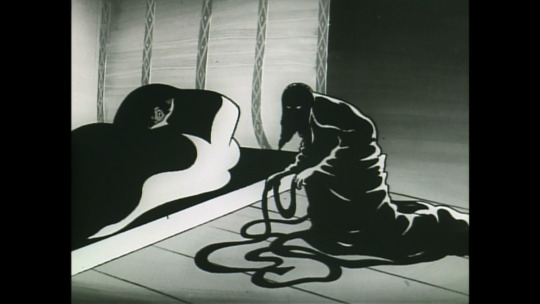
Dororo (1969) episode 4: The Scroll of Bandai Part 2
Time marches on however, and after 50 years it’s time for another studio to take a swing at Dororo. Mappa is a small animation studio established in 2011, founded by Masao Maruyama, producer and co-founder of Madhouse, who left Madhouse to pursue his own passions and took some staff with him. Maruyama would later leave Mappa in 2016 unfortunately, but the studio to this day has still been producing hits since. The staff behind their current Dororo adaptation is helmed by Kazuhiro Furuhashi as director, Satoshi Iwataki as character designer, Yasuko Kobayashi in charge of scripts, and Yoshihiro Ike composing the music. Background animation is handled by Studio Pablo. Dororo is produced by Twin Engine, a production company with its main focus being the creators of the medium. Founded by Kouji Yamamoto, Twin Engine wishes to let young artist focus on creating anime, ignoring popular trends instead pursuing only the art of the medium; often commissioning work from studios to keep them financially afloat. Dororo, like a large majority of Twin Engine produced series, streams worldwide on Amazon Prime.

My final aside before diving into some thoughts on how both adaptations compare is that when it comes to adapting Tezuka’s iconic designs to the form of animation there are often changes made. The more Disney-esque look of his drawings can be hard to pull off for action animation, and well, giant noses, and bushy mustaches are well and good, but when you’re trying to sell hideous monsters chomping people into bits, maybe they are not that fitting for this story. That’s why both the 1969 Mushi Pro and 2019 Mappa series have their own takes on the design of the characters. Mushi Pro sorta goes for making protagonist Hyakkimaru more buff, and adult looking, whereas Mappa makes their Hyakkimaru slim and more ikemen. I think both approaches work fine for the story at hand, and are interesting time capsules of themselves for their own eras.
So let’s compare the first episode of both series!

Both episodes start in a similar fashion, with Feudal Lord Daigo Kagemitsu making a deal to 48 Demons and sacrificing his then unborn son in the process. However even this early on we can see differences between the two adaptations.
In the 1969 Mushi Pro version Daigo willingly offers up his own son to the demons, and does so for power, asking them to grant him all of Japan under his rule, whereas in the 2019 Mappa version Daigo only offers the demons anything they want in return, never directly giving them his own son, and asks for the demons to give him the power and prestige he will need to rule over Japan.
At first I felt that Mappa may have made Daigo a bit more sympathetic, him seemingly asking for his own province to be granted protection from disease, famine, and war is certainly something we haven’t seen out of the character, but were perks he does enjoy later in the story regardless. As I ruminated on it however, I realized it’s more of an attempt to round out his character and add some extra depth to him. Sure those may have been great things for a Feudal Lord to ask for, but Daigo really only cares about one thing, and that’s ruling Japan; this has yet to change. Daigo still has no qualms about his own son Hyakkimaru being born a hideous freak and still throws away the newborn baby to die in some river while yelling at his wife to make another one to replace it.
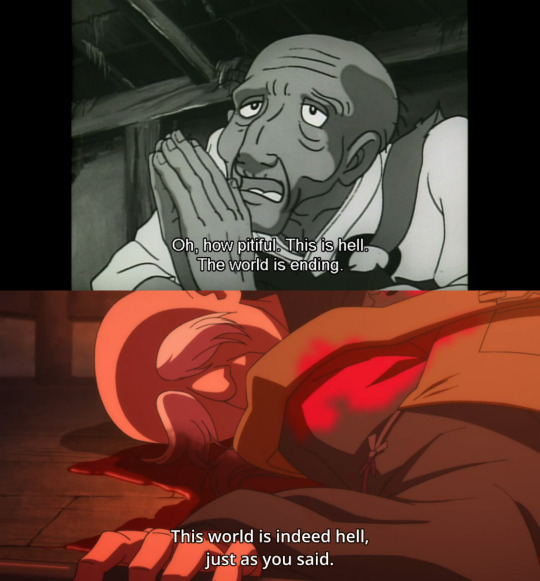
One Buddhist monk starves to death while bemoaning the state of Japan while another is slain and bemoans the current state of affairs in Japan
Then there’s Daigo killing a Buddhist monk. This scene does not exist in the 1969 Mushi Pro version (but Daigo does murder the monk albeit under different circumstances in the manga) and I have quite a bit to say about that. Daigo’s conversation with this monk, again, shows him off to be a bit more well rounded. He’s still selling his soul to the devil, but we can see his own level of commitment to his ambition when talking to the monk. The monk also plays another role that mirrors Mushi Pro’s first episode. In Mushi Pro’s debut episode Dororo comes across a starving Buddhist monk that can do nothing but beg for food and pray, and eventually succumbs to his starvation and dies. Both monks remark about the horrors of the current sengoku era being like Hell on Earth, and are meant to communicate to the audience that this particular time in Japanese history is perhaps one of the cruelest.

1969 or 2019, Daigo is still a dirt-bag and makes his wife suffer.
Let’s talk about Hyakkimaru’s birth as I think it’s a pretty interesting contrast between these two adaptations. In the 1969 Mushi Pro version Daigo already knows his son should be born a monster so upon seeing the hideous freak that is his baby boy, he proudly declares “My end of the bargain is fulfilled!” The demons have accepted Daigo’s offer and he can’t be happier. In the 2019 Mappa version Daigo is not aware of what the demons will take until a bolt of lighting strikes the room his wife is giving birth in. Upon seeing the baby up close (something not seen in the 1969 version until the second episode) Daigo realizes what has happened and orders the baby killed. We then get a conversation about a Buddhist statue that happened to break in the same room. The wet nurse believes it sacrificed itself in order to save the baby, giving a sorta strange implication that perhaps the deal wasn't to take 48 body parts from Hyakkimaru but to take everything from him, including his life. In fact we never really even establish if there are 48 demons, or 48 body parts missing, so the number may vary, and the kind of curse could be different. If that is true, it is certainly a unique approach to the series.

The image of baby Hyakkimaru from Mushi Pro's 1969 Dororo adaptation is taken from the second episode as it was not shown in the first episode.
Hyakkimaru’s birth between the two versions shows how both mirror each other--we have less subtle writing but more subtle animation in the 1969 Mushi Pro adaptation, and more subtle writing but super over-the-top animation in the 2019 Mappa adaptation. I find this maybe the best way to compare these two anime entirely so far. There is no huge lightning bolt smiting the room Daigo’s wife is giving birth in with the Mushi Pro version, instead you hear the mother scream in terror upon Hyakkimaru's birth as she breaks down and cries. Daigo and his wife's expressions of horror at the baby is the only clear indication of Hyakkimaru's hideousness instead of just showing the baby like Mappa did. But the Mappa version is trying to give some more depth to its characters, and maybe even to its own world with added bits such as the Buddhist statue maybe protecting Hyakkimaru. Both adaptations seems to have reverse on what they want to be subtle about and what they want to be over-the-top about.
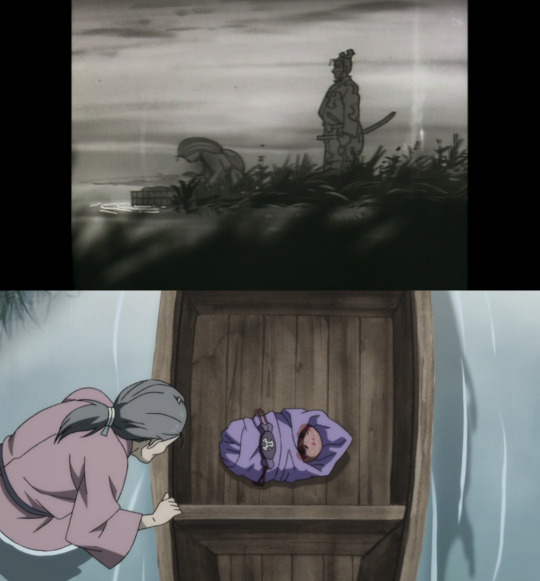
In the 1969 Mushi Pro version Daigo and his wife send Hyakkimaru down the river in a basket themselves, where as in the 2019 Mappa version Daigo orders the wet nurse to drown Hyakkimaru in the river, but she pities the baby and places him in an abandoned boat then pushes it down the stream. And then a demon shows up and murders her out of nowhere and is slain by the blind monk Zato (a character that didn't appear until Hyakkimaru narrates his past to Dororo a little later in the story). Yeah, that was a really weird addition to the story Mappa made. It’s certainly more over-the-top and gets a bit more action into an episode that amounts to basically all set-up, so there is that, I guess. Still really weird to see Zato show up like this.
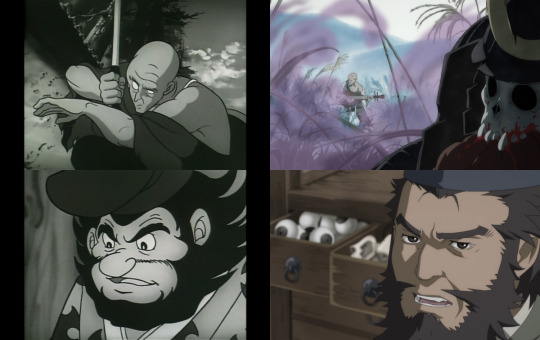
Both Zato and Jukai don't make their introduction until Hyakkimaru explains his past to Dororo in the second episode of the 1969 Mushi Pro Dororo.
Speaking of adding in characters earlier than before, Mappa included scenes that would interrupt the episode every now and again that focus on a doctor who gives prosthetics to dead maimed warriors so they can rest in peace. These scenes did not exist in the 1969 Mushi Pro version, which didn't show Jukai until episode 2 where it tells the story of how he saved a baby in the river he found, Hyakkimaru, and gave it prosthetics.

The introduction to Dororo is pretty similar in both versions, but more drawn out in the 1969 Mushi Pro adaptation. As discussed above with Daigo and the Buddhist monk, there was a scene where a starving monk begs Dororo for food before succumbing to his own starvation and dying, this was not present in the 2019 Mappa adaptation. Dororo gets more time to just do some general hijinks and mess around in town in Mushi Pro's version as well, before finally stealing food from some lowlifes and getting the crap kicked out of him by the riverbank.
In the Mappa version instead of stealing food from lowlifes Dororo steals their cargo and tries to pawn it but is caught then beaten at the riverbank. I imagine Mappa was just trying to streamline Dororo's introduction here for time constraints so they did their best to get across that he’s a thief while also making sure he ends up at the riverbank right away. Either way both adaptations lead to this slime looking monster appearing out of a pile of garbage in the river and eating the lowlife. Mappa’s more over the top animation has the monster swinging around its arms wildly until eventually grabbing said lowlife and making a snack out of him, where Mushi Pro has it slowly slither on top of the lowlife and then melts him. Ouch, that’s kinda way more messed up.
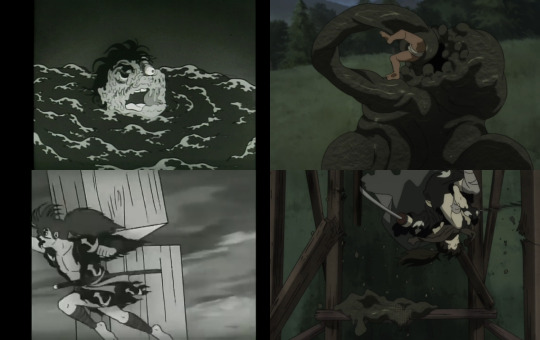
The lowlife gets melted by the monster in the manga too.
From this point on both adaptations are pretty much entirely the same, with just differences in animation quality being really all there is to comment on. The fight scene between Hyakkimaru and the slime in Mappa’s version is fantastic, with Hyakkimaru performing incredible acrobatics, jumping all around the bridge and slicing the whole thing up until it collapses on top of the slime killing it, where Mushi Pro … well they did their best, okay.

The real big difference is that Dororo seems a lot more intelligent when approaching Hyakkimaru in the 2019 Mappa version. Dororo was very quick to notice that Hyakkimaru is blind, and that his body is made up of mostly prosthetics. The 1969 Mushi Pro Dororo ends up getting terrified in the very next episode upon the realization that Hyakkimaru’s eyes are fake (he admittedly popped his glass eyes out of his head though to scare Dororo away).

The 2019 Mappa version has it that the riverbank monster was apparently one of the 48 demons Hyakkimaru needed to slay in order to regain his body parts, this one giving him back his skin. Hyakkimaru was actually born with his skin in the 1969 Mushi Pro version (as well as in the manga), and the monster was not the first demon he needed to kill but just a run-of-the-mil yokai that awarded him no regenerated body parts. Hyakkimaru actually worded it as "the dead", which have no true shape of their own and just latch onto anything, in this case the garbage in the river--thus making the slime monster we saw. Again I think Mappa was trying to kill two birds with one stone and get the audience acquainted with the series quicker since the general plot is essentially Hyakkimaru slays monster, Hyakkimaru grows back lost body part. This was a good way to streamline things, and it was with a body part that he wasn't missing before so it takes away nothing from later parts of the story.

And this is the biggest difference right here at the end of the episode, Hyakkimaru has yet to talk. He may not be able to speak at all until he’s slain enough demons to get this ability back. The Mappa version has so far seemed to point to Hyakkimaru being mute, deaf and blind, and completely cut off from the world. The Mushi Pro version had Hyakkimaru lack his eyeballs, his mouth, and his ears, but he could still speak and hear (just like in the manga). I always assumed it was just his outer ear missing but he still had all his inner ear like his eardrums, and well, you can talk without lips, so there was that too. The Mappa version seems to fully commit to Hyakkimaru being born without all his senses, and if it’s true it will be a super interesting take on the character to be sure. It will also be hard to pull off considering how much he speaks in the original story; he's a very vocal character, so if it is true, until he regains his ability to speak Dororo has to be the one to carry the duo in conversations entirely now which will lead to major shake-ups in the plot.
What do you think of the newest anime adaptation of Dororo. Are you excited to see the classic come back for modern times? Do you wish it was more like the manga or are you enjoying all these attempts to create something more modern with the source material? Do you think Hyakkimaru will speak in the next episode or do you think he's actually going to start the show as a mute? Are you looking forward to keeping up with this new adaptation of Dororo?

PS - Shout out to Mappa for putting a dog into their first episode that resembles Nota, the mascot character invented for the 1969 Mushi Pro series in a vain attempt to prevent the children that were watching it from being emotionally scarred (it probably didn't).
#Dororo#Hyakkimaru to Dororo#Hyakkimaru and Dororo#Hyakkimaru#Mushi Productions#Mushi Pro#Mappa#Studio Mappa#anime
40 notes
·
View notes
Text
Convention-Thinking
youtube
In this interview, the host asks Norm “…a lot of books by celebrities are confessional, telling the story behind the story. With this book, you turn that model on it’s head. You’ll take a kernel of truth and spin it into a ridiculous story, like the time you worked on SNL and ended up with a 40 year prison sentence for contracting a hitman to kill a writer. Some reviewers have said the book ridicules audiences looking for some juicy gossip. Does that criticism hold any water for you?”
And Norm replies “No, I wasn’t trying to do it. But I did immediately understand that backstage holds nothing in show business. Back stage is just you’re eating a sandwich trying to figure out what to do on stage. On stage is the real thing. And so what I was trying to do with the book, to make that point strongly, was to make the book not backstage either but rather onstage. I wanted to make the book a work, not talking about some other work.”
This phrasing here gets at a core problem I have with conventions in video games. “I wanted to make the book a work, not talking about some other work.” The problem with conventions and referencing other works in your own is the possibility of the reference smuggling in more beauty than your own contribution creates. When this is the case, you are not creating much at all. You are taking credit for something you merely understood and imitated. And the deeper problem with this is the desires that cause us to act in this way.
Life is confusing and making sense of the world takes enormous effort. Creating order from this chaos can often feel like stumbling around in the dark. It’s unclear if your production has any value. Rather than embrace this terrifying predicament, many choose to wrap themselves in the warm blanket of bygone eras. They rely on these social molds to make their decision making easier. But in doing so, they give up their own agency.
This is especially a problem in unseen aspects of a work, like game design, but is a problem for all parts. Pixel art is an easy example for to explain.
Pixel art in it’s modern form is not so much like its birthplace. We no longer have color palette, sprite size, frame count or many of the limitations that existed when pixel art began. And this is a good thing, a great thing. Because as it turns out, pixel art is a deep medium in its own right. It has an enormous potential for expression and can be used for many divine purposes. But most people refuse to see pixel art for itself and to use it’s strengths to manifest their inspiration directly. They like their chains and willingly act out their mental slavery by dutifully replicating styles of the past, aping a bygone era of limitations which do not exist now. This is not to say that any convention is inherently bad. Many or maybe even most conventions have arrised through their own merit. Or at least, they must offer something good to the world or else their memetic lineage won’t continue forever.
But this is where things begin to get tricky. We start to think there is something inherently beautiful about a particular era or style, regardless of whether or not we have truly examined it and noticed its pros and cons. We fetishize to the past because its the only thing we understand.

It’s easier to notice these kinds of problems with mediums we can sense more directly. Visual, audio, kinematic. But with fields like game design, we do not have so many direct impulses to guide us. Or rather, we do, but they are not spoken about deeply or understood thoroughly. We must look inside ourselves carefully to see what’s going on. Clicker games may feel good, yet its not goodness we feel but hideous greed. Headshotting on fools may feel grandiose, but really its a quite a frail act made in the desperation for dominance. It’s not that numbers-go-up is bad, or conquering-your-enemies is shallow. But we must look closely and determine the pros and cons. Once we understand the strengths of a visual style, a game mechanic or structure, then we can use those strengths without awkwardly leaning forwards and back simultaneously.
We cannot simply give the player (ourselves) what they want. What I want is a river of chocolate to dive into. Can you even swim in chocolate or will you drown? Let’s not find out the hard way. Let’s steer the ship and find the uncharted territory. Lets explore the wilds and bring the best of it back to share with our players. They will come along with us gladly if we lead the way.
0 notes
Link
The Limitless Perspective of Master Peek, or, the Luminescence of Debauchery By Catherynne M. Valente
Issue #200, Special Double-Issue
, May 26, 2016
AUDIO PODCAST
EBOOK
(Finalist, Eugie Foster Memorial Award, 2017)
When my father, a glassblower of some modest fame, lay gasping on his deathbed, he offered, between bloody wheezings, a choice of inheritance to his three children: a chest of Greek pearls, a hectare of French land, or an iron punty. Impute no virtue to my performance in this little scene! I, being the youngest, chose last, which is to say I did not choose at all. The elder of us, my brother Prospero, seized the chest straightaway, having love in his heart for nothing but jewels and gold, the earth’s least interesting movements of the bowel which so excite, in turn, the innards of man. Pomposo, next of my blood, took up the deed of land, for he always fancied himself a lord, even in our childhood games, wherein he sold me in marriage to the fish in the lake, the grove of poplar trees, the sturdy stone wall, our father’s kiln and pools of molten glass, even the sun and the moon and the constellation of Taurus. The iron punty was left to me, my father’s only daughter, who could least wield it to any profit, being a girl and therefore no fit beast for commerce. All things settled to two-thirds satisfaction, our father bolted upright in his bed, cried out: Go I hence to God! then promptly fell back, perished, and proceeded directly to Hell.
The old man had hardly begun his long cuddle with the wormy ground before Prospero be-shipped himself with a galleon and sailed for the Dutch East Indies in search of a blacker, more fragrant pearl to spice his breakfast and his greed whilst Pomposo wifed himself a butter-haired miller’s daughter, planting his seed in both France and her with a quickness. And thus was I left, Perpetua alone and loudly complaining, in the quiet dark of my father’s glassworks, with no one willing to buy from my delicate and feminine hand, no matter how fine the goblet on the end of that long iron punty.
The solution seemed to me obvious. Henceforward, quite simply, I should never be a girl again. This marvelous transformation would require neither a witch’s spell nor an alchemist’s potion. From birth I possessed certain talents that would come to circumscribe my destiny, though I cursed them mightily until their use came clear: a deep and commanding voice, a masterful height, and a virile hirsuteness, owing to a certain unmentionable rootstock of our ancient family. Served as a refreshingly exotic accompaniment to these, some few of us are also born with one eye as good as any wrought by God, and one withered, hardened to little more than a misshapen pearl notched within a smooth and featureless socket, an affliction which, even if all else could be made fair between us, my brothers did not inherit, so curse them forever, say I. No surprise that no one wanted to marry the glassblower’s giant hairy one-eyed daughter!
Yet now my defects would bring to me, not a husband, but the world entire. I had only to cut my hair with my father’s shears, bind my breasts with my mother’s bridal veil, clothe myself in my brothers’ coats and hose, blow a glass bubble into a false eye, and think nothing more of Perpetua forever. My womandectomy caused me neither trouble nor grief—I whole-heartedly recommend it to everyone! But, since such a heroic act of theatre could hardly be accomplished in the place of my birth, I also traded two windows for a cart and an elderly but good-humored plough-horse, packed up tools and bread and slabs of unworked glass, and departed that time and place forever. London, after all, does not care one whit who you were. Or who you are. Or who you will become. Frankly, she barely cares for herself, and certainly cannot be bothered with your tawdry backstage changes of costume and comedies of mistaken identity.
That was long ago. So long that to say the numbers aloud would be an act of pure nihilism. Oh, but I am old, good sir, old as ale and twice as bitter, though I do not look it and never shall, so far as I can tell. I was old when you were weaned, squalling and farting, and I shall be old when your grandchildren annoy you with their hideous fashions and worse manners. Kings and queens and armadas and plagues have come and gone in my sight, ridiculous wars flowered and pruned, my brothers died, the scales balanced at last, for having not the malformed and singular eye, neither did they have the longevity that is our better inheritance, fashions swung from opulence to piousness and back to the ornate flamboyance that is their favored resting state once more.
And thus come I, Master Cornelius Peek, Glassmaker to the Rich and Redolent, only slightly dented, to the age which was the mate to my soul as glove to glove or slipper to slipper. Such an age exists for every man, but only a lucky few chance to be born alongside theirs. For myself, no more perfect era can ever grace the hourglass than the one that began in the Year of Our Lord 1660, in the festering scrotum of London, at the commencement of the long and groaning orgy of Charles II’s pretty, witty reign.
If you would know me, know my house. She is a slim, graceful affair built in a fashion somewhat later than the latest, much of brick and marble and, naturally, glass, three stories high, with the top two being the quarters I share with my servants, the maid-of-all-work Mrs. Matterfact and my valet, Mr. Suchandsuch (German, I believe, but I do respect the privacy of all persons), and my wigs, my wardrobe, and my lady wife, when I am in possession of such a creature, an occurrence more common and without complaint than you might assume, (of which much more, much later). I designed the edifice myself, with an eye to every detail, from the silver door-knocker carved in the image of a single, kindly eye whose eyelid must be whacked vigorously against the iris to gain ingress, to the several concealed chambers and passageways for my sole and secret use, all of which open at the pulling of a sconce or the adjusting of an oil painting, that sort of thing, to the smallest of rose motifs stenciled upon the wallpaper.
The land whereupon my lady house sits, however, represents a happy accident of real estate investment, as I purchased it a small eternity before the Earl of Bedford seized upon the desire to make of Covent Garden a stylish district for stylish people, and the Earl was forced to make significant accommodations and gratifications on my account. I am always delighted by accommodations and gratifications, particularly when they are forced, and most especially when they are on my account.
The lower floor, which opens most attractively onto the newly-christened and newly-worthwhile Drury Lane, serves as my showroom, and in through my tasteful door flow all the nobly whelped and ignobly wealthed and blind (both from birth and from happenstance, I do not discriminate) and wounded and syphilitic of England, along with not a few who made the journey from France, Italy, Denmark, even the Rus, to receive my peculiar attentions. With the most exquisite consideration, I appointed the walls of my little salon with ultramarine watered silk and discreet, gold-framed portraits of my most distinguished customers. In the northwest corner, you will find what I humbly allege to be the single most comfortable chair in all of Christendom, reclined at an, at first glance, radical angle, that nevertheless offers an extraordinary serenity of ease, stuffed with Arabian horsehair and Spanish barley, sheathed in supple leather the color of a rose just as the last sunlight vanishes behind the mountains. In the northeast corner, you will find, should you but recognize it, my father’s pitted and pitiful iron punty, braced above the hearth with all the honor the gentry grant to their tawdry ancestral swords. The ceiling boasts a fine fresco depicting that drunken uncle of Greek Literature, the Cyclops, trudging through a field of poppies and wheat with a ram under each arm, and the floor bears up beneath a deep blanket of choice carpets woven by divinely inspired and contented Safavids, so thick no cheeky draught even imagines it might invade my realm, and all four walls, from baseboard to the height of a man, are outfitted with a series of splendid drawers, in alternating gold and silver designs, presenting to the hands of my supplicants faceted knobs of sapphire, emerald, onyx, amethyst, and jasper. These drawers contain my treasures, my masterpieces, the objects of power with which I line my pockets and sauce my goose. Open one, any one, every one, and all will be revealed on plush velvet cushions, for there rest hundreds upon hundreds of the most beautiful eyes ever to open or close upon this fallen earth.
No fingers as discerning as mine could ever be content with the glazier’s endless workaday drudge through plate windows and wine bottles, vases and spectacles and spyglasses, hoping against hope for the occasional excitement of a goblet or a string of beads that might, if you did not look too closely, resemble, in the dark, real pearls. No, no, a thousand, million times no! Not for me that life of scarred knuckles whipped by white-molten strands of stray glass, of unbearable heat and even more unbearable contempt oozing from those very ones who needed me to keep the rain out of their parlors and their spirits off the table linen.
I will tell you how I made this daring escape from a life of silicate squalor, and trust you, as I suppose I already have done, to keep my secrets—for what is the worth of a secret if you never spill it? My deliverance came courtesy of a pot of pepper, a disfigured milkmaid, and the Dogaressa of Venice.
It would seem that my brothers were not quite so malevolently egomaniacal as they seemed on that distant, never-to-be-forgotten day when our father drooled his last. One of them was not, at least. Having vanished neatly into London and established myself, albeit in an appallingly meager situation consisting of little more than a single kiln stashed in the best beloved piss-corner of the Arsegate, marvering paltry, poignant cups against the stone steps of a whorehouse, sleeping between two rather unpleasantly amorous cows in a cheesemaker’s barn, I was neither happy nor quite wretched, for at least I had made a start. At least I was in the arms of the reeking city. At least I had escaped the trap laid by pearls and hectares and absconding brothers.
And then, as these things happen, one day, not different in any quality or deed from any other day, I received a parcel from an exhausted-looking young man dressed in the Florentine style. I remember him as well as my supper Thursday last—the supper was pigeon pie and fried eels with claret; the lad, a terrifically handsome black-haired trifle who went by the rather lofty name of Plutarch—and after wiping the road from his eyes and washing it from his throat with ale that hardly deserved the name, he presented me with a most curious item: a fat silver pot, inlaid with a lapis lazuli ship at full sail.
Inside found I a treasure beyond the sweat-drenched dreams of upwardly mobile men, which is to say, a handful of peppercorns and beans of vanil, those exotic, black and fragrant jewels for which the gluttonous world crosses itself three times in thanks. Plutarch explained, at some length, that my brother Prospero now dwelt permanently in the East Indies where he had massed a fabulous fortune, and wished to assure himself that his sister, the sweet, homely maid he abandoned, could make herself a good marriage after all. I begged the poor boy not to use any of those treacherous words again in my or anyone’s hearing: not marriage, not maid, and most of all not sister. Please and thank you for the pepper, on your way, tell no one my name nor how you found me and how did you find me by God and the Devil himself—no, don’t tell me, I shall locate this lost relative and deliver the goods to her with haste, though I could perhaps be persuaded to pass the night reading a bit of Plutarch before rustling up the wastrel in question, but, hold fast, my darling, I must insist you submit to my peculiar tastes and maintain both our clothing and cover of darkness throughout; I find it sharpens the pleasure of the thing, this is my, shall we say, firm requirement, and no argument shall move me.
Thus did I find myself a reasonably rich and well-read man. And that might have made a pleasant and satisfying enough end of it, if not for the milkmaid.
For, as these things happen, one day not long after, not different in any hour or act than any other day, a second parcel appeared upon my, now much finer, though not nearly so fine as my present, doorstep. Her name was Perdita, she was in possession of a complexion as pure as that of a white calf on the day of its birth, hair as red as a fresh wound, an almost offensively pregnant belly, and to crown off her beauty, it must be mentioned, both her eyes had been gouged from her pretty skull by means of, I was shortly to learn, a pair of puritanical ravens.
It would seem that my other brother, Pomposo—you remember him, yes? Paying attention, are we?—was still in the habit of marrying unsuspecting girls off to trees and fish and stones, provided that the trees were his encircling arms, the fish his ardent tongue, and the stones those terribly personal, perceptive, and pendulous seed-vaults of his ardor, and poor, luckless Perdita had taken quite the turn round the park. Perhaps we are not so divided by our shared blood as all that, Pomposo! Hats off, my good man, and everything else, too. Well, the delectably lovely and lamentable maid in question found herself afflicted both by Little Lord Pomposo and by that peculiar misfortune which bonds all men as one and makes them brothers: she had a bad father.
Perdita told me of her predicament over my generous table. She spoke with more haste than precision, tearing out morsels of Mrs. Matterfact’s incomparable baked capon in almond sauce with her grubby fingers and fumbling it into that plump face whilst she rummaged amongst her French pockets for English words to close in her tale like a green and garnishing parsley. As far as I could gather, her cowherding father had, in his youth, contracted the disease of religion, a most severe and acute strain. He took the local clergyman’s daughter to wife, promptly locked her in his granary to keep her safe from both sin and any amusement at all, and removed a child from her every year or so until she perished from, presumably, the piercing shame of having tripped and fallen into one of the more tiresome fairy tales.
Perdita’s father occupied the time he might have spent not slowly murdering his wife upon his one and only hobby: the keeping of birds of prey. Now, one cannot fault the man for that! But he loved no falcons nor hawks nor eagles, only a matched pair of black-hearted ravens he called by the names of Praisegod and Feargod (there really can be no accounting for, or excusing of, the tastes of Papists) which he had trained from the egg to hunt down the smallest traces of wickedness upon his estate and among his children. For this unlikely genius had taught his birds, painstakingly, to detect the delicate and complex scents of sexual congress, and the corvids twain became so adept that they were known to arrive at many a village window only moments after the culmination of the act.
Now you have taken up all the pieces of this none-too-sophisticated puzzle and can no doubt assume the rest. My brother conquered Perdita’s virtue with ease, for no such dour and draconian devoutness can raise much else but libertines, a fact which may yet save us from the vicious fate of a world redeemed, and put my niece (for indeed it proved to be a niece) in her with little enough care for anything but the trees and the fish and the stones of his own bucolic life. No sooner than he had rolled off of her but Praisegod and Feargod arrived, screeching to wake the glorious dead, the scent of coupling maddening their black brains, and devoured Perdita’s eyeballs in a hideous orgy of gore and terribly poor parenting. Pomposo, ever steadfast and humbly responsible for his own affairs, sent his distress directly to me and, I imagine, poured a brimming glass of wine with which to toast himself.
“My dear lady,” said I, gently prying a joint of Mrs. Matterfact’s brandied mutton from her fist, hoping to preserve at least something for myself, “I cannot imagine what you or my good brother mean me to do with a child. I am a bachelor, I wish devoutly to remain so, and my bachelorhood is only redoubled by my regrettable feelings toward children, which mirror the drunkard’s for a mug of clear water: well enough and wholesome for most, he supposes, but what can one do with one? But I am not pitiless. That, I am not, my dear. You may, of course, remain here until the child... occurs, and we shall endeavor to locate some suitable position in town for one of your talents.”
Ah, but I had played my hand and missed the trick! “You misunderstand, monsieur,” protested the comely Perdita. “Mister Pompy didn’t send me to you for your hospitalité. He said in London he had a brother who could make me eyes twice as pretty as they ever were and would only charge me the favor of not squeezing out my babe on his parlor floor.”
Even a thousand miles distant, my skinflint family could put the screws to me, turn them tight, and have themselves a nice giggle at my groans. But at least the old boy guessed my game of trousers and did not give me up, even to his paramour.
“They was green,” the milkmaid whispered, and the ruination of her eye sockets bled in place of weeping. “Like clover.”
Oh, very well! I am not a monster. In any event, I wasn’t then. At least the commission was an interesting enough challenge to my lately listless and undernourished intellect. So it came to pass that over the weeks remaining until the parturition of Perdita, I fashioned, out of crystal and ebony and chips of fine jade, twin organs of sight not the equal of mortal orbs but by far their superior, in clarity, in beauty, even in soulfulness. If you ask me how I accomplished it, I shall show you the door, for I am still a tradesman, however exalted, and tradesmen tell no tales. I sewed the spheres myself with thread of gold into her fair face, an operation which sounds elegant and difficult in the telling, but in the doing required rather more gin, profanity, and blows to the chin than any window did. When I had finished, she appeared, not healed, but more than healed—sublimated, rarefied, elevated above the ranks of human women with their filmy, vitreous eyes that could merely see.
I have heard good report that, under another name, and with her daughter quite grown and well-wed, Perdita now sits upon the throne of the Netherlands, her peerless eyes having captivated the heart of a certain prince before anyone could tie a rock round her feet and drop her into a canal. Well done, say all us graspers down here, reaching up toward Heaven’s sewers with a thousand million hands, well done.
Now, we arrive at the hairpin turn in the road of both my fortunes and my life, the skew of the thing, where the carriage of our tale may so easily overturn and send us flying into mud and thorns unknown. Brace your constitution and your credulity, for I am of a mind to whip the horses and take the bend at speed!
It is simply not possible to excel so surpassingly as I have done and remain anonymous. God in his perversity grants anonymity to the gifted and the industrious in equal and heartless measure, but never to the splendid. Word of the girl with the unearthly, alien, celestial eyes spread like a plague of delight in every direction, floating down the river, sweeping through the Continent, stowing away on ships at sea, until it arrived, much adorned with my Lady Rumor’s laurels, at the palazzo of the Doge in darling, dripping Venice.
Now, the Doge at that time had caused himself, God knows why or by dint of what wager, to be married to a woman by the name of Samaritiana. Do not allow yourselves to be duped by that name, you trusting fools! Samaritiana would not even stop along the side of the road to Hell to wrinkle her nose at the carcass of Our Lord Jesus Christ, though it save her immortal soul, unless He told her she was beautiful first. Oh, ’tis easy enough to hate a vain woman with warts and liver spots, to scorn her milk baths and philtres and exsanguinated Hungarian virgins, to mock her desperation to preserve a youth and beauty that was never much more enticing than the local sheep in the first place, but one had to look elsewhere for reasons to hate Samaritiana, for she truly was the singular beauty of her age. Black of hair, eye, and ambition was she, pale as a maiden drowned, buxom as Ceres (though she had yet no issue), intoxicating as the breath of Bacchus. Fortunately, my lady thoughtfully provided a bounty of other pantries in which to find that meat of hatred fit for the fires of any heart.
She was, quite simply, the worst person.
I do not mean by this to call the Dogaressa a murderess, nor an apostate, nor a despot, nor an embezzler, nor even a whore, for whores, at least, are kindly and useful, murderers must have some measure of cleverness if they mean to get away with it, apostates make for tremendous company at parties, despots have a positively devastating charisma, and, I am assured by the highest authority, which is to say, Lord Aphorism and his Merry Band of Proverbials, that there is some honor amongst thieves. No, Samaritiana was merely humorless, witless, provincial, petty, small of mind, parched of imagination, stingy of wallet and affection, morally conservative, and incapable, to the last drop of her ruby blood, of admitting that she did not know everything in all the starry spheres and wheeling orbits of existence, and this whilst believing herself to possess all of these that are virtues and eschew all that are sins. Can you envisage a more wretched and unloveable beast?
I married her, naturally.
The Dogaressa came to me in a black resin mask and emerald hooded cloak when the plague had only lately checked into its waterfront rooms, sent for a litter, and commenced seeing the sights of Venice with its traveling hat and trusted map.
Oh, no, no, you misapprehend my phraseology. Not that plague. Not that grave and gorgeous darkling shadow that falls over Europe once a century and reminds us that what dwells within our bodies is not a soul but a stinking ruin of fluid and marrow and bile. The other plague, the one that sneaks on nimbly putrefying feet from bedroom to bedroom, from dockside to dinner party, from brothel to marital bower, leaving chancres like kisses too long remembered. Yes, we would have to wait years yet before Baron von Bubœ mounted his much-anticipated revival on the stage, but never you fear, Dame Syphilis was dancing down the dawn, and in those days, her viols never stopped nor slowed.
That mysterious, morbid, nigh-monstrous and tangerine-scented creature called Samaritiana darkened my door one evening in April, bid me draw close all my curtains, light only a modest lantern upon a pretty lacquered table inlaid with mother of pearl which I still possess to this day, and stand some distance away while she removed her onyx mask to reveal a face of such surpassing radiance, such unparalleled winsomeness, that even the absence of the left eye, and the mass of scars and weals that had long since replaced it, could do no more than render her enchanting rather than perfect.
It would seem that the Dogaressa danced with the Dame some years past. Her husband, the Doge, brought her to the ball, she claimed, having learned the steps from his underaged Neapolitan mistress, though, as I became much acquainted with the lady in later years, I rather suspect she found her own way, arrived first, wore through three pairs of shoes, departed last, and ate all the cakes on the sideboard. But, as is far too often the case in this life ironical, that mean and miserly soul found itself in receipt of, not only the beauty of a better woman, but the good fortune of a better man. She contracted a high fever owing to her insistence upon hosting the Christmas feast out of doors that year, so that the gathered noblility could see how lovely she looked with a high winter’s blush on her cheeks, and this fever seemed to have driven, by some idiot insensate alchemy, the Dame from the halls of Samaritiana forever, leaving only her eye ravaged and boiled away by the waltz.
All was well in the world, then, save that she could not show herself in public without derision and her husband still rotted on his throne with a golden nose hung on his mouldering face like a door knocker, but she had not come for his sake, nor would she ever dream of fancying that it was possible to ask a boon of that oft-rumored wizard hiding in the sty of London for any single soul on earth other than herself.
“I have heard that you can make a new eye,” said she, in dulcet tones she did not deserve the ability to produce.
I could.
“Better than the old, brighter, of any color or shape?”
I could.
She licked her lily lips. “And install it so well none would suspect the exchange?”
Perhaps not quite, not entirely so well, but it never behooves one to admit weakness to a one-eyed queen.
“You have already done me this service,” said she to me, loftily, never asking once, only demanding, presuming, crushing all resistance, not to mention dignity, custom, the basest element of courtesy, beneath her silver-tooled heel. She waved her hand as though the motion of her fingers could destroy all protestation. The light of my lantern caught on a ring of peridot and tourmaline entwined into the shape of a rather maudlin-looking crocodile gnawing upon its own tail, for she claimed some murky Egyptian blood in the dregs of her familial cup, as though such little droplets could mark her as exceptional, when every dockside lady secretly fancies herself a Cleopatra of the Thames.
“Produce the results upon the morrow! I will pay you nothing, of course. A Dogaressa does not stoop to exchange currency for goods. But when two eyes look out from beneath my brow once more, I will present you with a gift, for no particular reason other than that I wish to bestow it.”
“And if I do not like your gift, Clarissima?”
Puzzlement contorted her exquisitely Cyclopean visage, causing a most unwelcome familial pang within my breast. “I do not take your meaning, Master Peek. How could such a thing possibly occur?”
There is, it seems, a glittering point beyond which egotism achieves such purity that it becomes innocence, and that was the country in which Samaritiana lived. In truth, had she revealed her gift to me then, or even promised payment in the usual manner, I might have refused her, just to experience the novel emotion of rejecting royalty—for I am interested in nothing so much as novelty, not love nor death nor glass nor gold. Something new! Something new! My kingdom for something new! But she caught me, the perfumed spider, wholly without knowing what she’d done. I did indeed take up her commission, and though you may conclude in advance that this recounting of the job will proceed according to the pattern of the last, I shall be disappointed if you do, for I have already told you most vividly that herein lies the skew of my tale.
For the sake of the beautiful Dogaressa, I took up my father’s battered old pipe and punty. I cannot now say why; for a certainty I owned better instruments by far, and had not touched the things in eons except to brush them daintily with a daily sneer. Perhaps a paroxysm of sentimentality seized me; perhaps I despised her too much even then to waste my finer appliances on her pox-punched face, in any event, I cannot even say positively that the result blossomed forth from the tools and not some other cause, and I fear to question it now. I sank into the rhythm of my father and grandfather and his before him: the dollop of liquid glass, the greatbreath of my own lungs expelled through the long, black pipe, the sweet pressure and rolling of the globule against the smooth marver stone, the uncommon light known only to workers of glass, that strange slick of marmalade-light afire within crystal that would soon ride a woman’s skull all the way through the days of her life and down into her tomb.
The work was done; I fashioned two, an exquisitely matched pair, in case the other organ required replacement in the unseen feverish future. Samaritiana, in, so far as I may know or tell, the sole creative decision of her existence, chose not one color for the iris but all of them, dozens of infinitesimal shards chipped from every jewel in my inventory: sapphire, jade, emerald, jasper, onyx, amethyst, ruby, topaz. The effect was a carnival wheel of deep, unsettling fascination, and when I sewed it into her flesh with my golden thread she did not wail or struggle but only sighed, as though lost in the act of love, and, though her faults were called Legion, they were as yet unknown to me, thus, as my needle entered her, so too did my fatal softening begin.
The Dogaressa departed with her stitching still fresh, leaving in her wake but three souvenirs of our intimate surgery: one gift she intended, one she did not, and her damnable scent, which neither Mrs. Matterfact nor Mr. Suchandsuch, no matter how they scrubbed and strove, could remove from the premises. I daresay, even this very night, should you venture to my old house on the High Street and press your nose to its sturdy bones, still yet you would snatch a whiff of tangerine and strangling ivy from the foundation stones.
The gift she intended to leave was a lock of her raven hair, the skinflint bitch. The other, I did not perceive until some weeks later, when I adjourned to my smoking room with a bottle of brandy, a packet of snuff, and a rare contemplative mood which I intended to spend upon a rich, unfiltered melancholy as sweet as any Madeira—for it is a fact globally acknowledged that idle melancholy, like good wine, is the exclusive purview of the wealthy. To aid in my melancholy, I fingered in one hand the mate to the Dogaressa’s harlequin eye, rubbing my thumb over that strange, motley iris, marveling at the milky sheen of the sclera, admiring, unrepentant Narcissus that I am, my own skill and artistry. I removed my own, ordinary, unguessable, nearly flawless glass eye and held up the other to my empty socket like a spyglass, and a most thoroughly stupendous metamorphosis transpired: I could seethrough the jeweled lens of that artificial eye! Truly see, without cloud or glare or halo—ah, but what I saw was not the walls of my own smoking room, so tastefully lined with matching books chosen to neither excite nor bore any guest to extremes, but the long peach-cream and gold hall of the palazzo of the Doge in far-distant Venice! The chequered black and white marble floors flowed forth in my vision like a houndstooth river; the full and unforgiving moon streamed glaucous through tall slim windows; painted ceilings soared overhead, inlaid with pearl and carnelian and ever-so-slightly greyed with the smoke of a hundred thousand candles burnt over peerless years in that grand corridor. Women and men swept slowly up and down the squares like boats upon some fairy canal, swathed in gowns of viridescent green cross-hatched with silver and rose, armored in bodices of whalebone and opal, be-sailed in lacy gauze spun by Clotho herself upon the wheel of destiny, cloaked and hooded in vermillion damask, in aquamarine, in citron and puce, their clothing each so splendid I could scarce tell the maids from the swains—and thus looked I upon a personal paradise heretofore undreamt of.
But there were worms in paradise, for each and every beauty in the Doge’s palace was rotting in their finery like the fruit of sun-spoiled melons within their shells. Their flesh putrefied and dripped from their bones and what remained turned hideous, sickening colors, choleric, livid, cyanic, hoary, a moldering patina of death whose effusions stained those bodices black. Some stumbled noseless, others having replaced that appendage with nostrils of gold and silver and crystal and porcelain, and others, all hope lost, sunk their visages into masks, though they could not hide their chancred hands, the bleeding sores of their bosoms, the undead tatters of their throats.
Yet still they laughed, and spoke animatedly, one to the other, and blushed in virtuous fashion beneath their putridity. Such is the dance of the Dame, who enters through the essential act of life, yet leaves you thinking, breathing, walking whilst the depredations of the grave transact upon your still-sensate flesh, making of this world a single noisy tomb.
My breath would not obey me; my heart ricocheted amongst my ribs like a cannon misfired. Was it truly Italy I saw bounded in the tiny planet of a glass eye? Had I stumbled into a drunken sleep or gone mad so swiftly no asylum could hope to catch me? I shot to my feet, mashing the eye deeper into my socket until stars spattered my sight—closer, look closer! Could I hear as well? Smell? Taste the tallowed air of that far-off moonlit court?
I could not. I could not hear their footsteps nor inhale their perfume nor feel the fuzzed reek of the mildewed canals on my tongue nor move of my own volition. I apprehended a new truth, that even the impossible possesses laws of its own, and those unbendable. I could only observe. Observe—while my vision lurched forward, advancing quickly, rocking gently as with a woman’s sinuous gait. Graceful, slender arms extended as though from my own body, opening with infinite elegance to embrace a man whose head was that of a Titan cast down brutally into the pit of Tartarus, so wracked with growths and intuberances and pulsating polyps that the plates of his skull had cracked beneath the intolerable weight and shifted into a new pate so monstrous it could no longer bear the Doge’s crown, which hung pitifully instead from a ribbon slung round his grotesque neck. Those matchless arms which were not my own enfolded this hapless creature and, encircling the middle finger of the hand belonging to the right arm, I saw with my altered vision the twisted peridot and tourmaline crocodile ring of the Dogaressa Samaritiana.
I cast the glass eye away from me, sickened, thrilled, inflamed, ensorcelled, the fire in my midnight hearth as nothing beside the conflagration of curiosity, horror, and the beginnings of power that crackled within my brain-pan. In that first moment, standing among my books and my brandy drenched in the sweat of a new universe, an instinct, a whisper of Truth Profound, permeated my spirit like smoke exhaled, and, I confess to you now, all these many years hence, still I enshrine it as an article of faith, for it was with breath that God animated the dumb mud of Adam, breath that woke Pandora from stone, breath that demarcates the living and the dead, breath with which we speak and cry out and divide ourselves from the idiot kingdom of animals, and breath, by all the blasted saints and angels, with which the glassblower shapes his glass! The living breath of Cornelius Peek yet permeates every insignificant atom of his works; each object broken from his punty, be it window or goblet or cask or eye, hides the sacred exhalations of his spirit co-mingled with the crystal, and it is this, it is this, I tell you, that connects the jeweled eye of the Dogaressa with the jeweled eye in my hand! I dwell in the glass, it cannot dispense with me any further than it can dispense with translucency or mass, and therefore it carries the shard of Cornelius whithersoever it wanders.
Let us dispense with a few obnoxious but inevitable inquiries into the practicality of the matter, so that we may move along past the skew. How could this mystic connection have escaped my notice till now? It is only sensical: Perdita vanished away to the Netherlands with both marvelous eyes, and no window nor goblet nor cask is, in its inborn nature, that organ of sight which opens onto the infinite pit of the human soul. Would any eye manufactured in the same fashion result in such remote visions? They would indeed, my credulous friend. Does every glassblower possess the ability to produce such objects, should he but retain one eye whilst selling the other at a fair price? Ah, here I must admit my deficiency as a philosopher, for which I apologize most obsequiously. It cannot be breath alone, for I made subtle overtures toward the gentleman of the glassmen’s guild and I can say with a solemn certainty that none but Master Peek can perform this alchemy of sclera and pupil. Why should it be so? Perhaps I am a wizard, perhaps a saint, perhaps a demiurge, perhaps the Messiah returned at last, perhaps it owes only to that peculiar rootstock of my family which grants me my height, my baritone, the hairiness of my body. Grandfather Polyphemus’s last gift, lobbed down the ancestral highway, bashing horses as it comes. I am a man of art, not science. I ask why Mrs. Matterfact has not yet laid out my supper oftener than I ask after the workings of the uncluttered cosmos.
Thus did I enter the business of optometry.
When you have placed a mad rainbow jewel in the skull of a Dogaressa as though she were nothing but a golden ring, a jewel which drove the rotting men of Venice insane with the desire to tie her to a bridge-post and stare transported into the motley swirling colors of the eye of God, lately fallen to earth, they began to say, somewhere in Sicily, advertisement serves little purpose. I opened my door and received the flood. It is positively trivial to lose an eye in this wicked world, did you know? I accepted them warmly, with a bow and a kerchief fluttered to the mouth in acute compassion, a permanently sympathetic expression penciled onto my lips in primrose paint—for that moth-eaten scab Cromwell was finally in the grave, where everything is just as colorless and abstemious and black as he always wished it to be, so full of piss and vitriol that it poisoned him to the gills, and Our Chuck, the Merry Monarch, was dancing on his bones.
Fashion, ever my God and my mother, took pity upon her poor supplicant and caused a great miracle to take place for my sake—the world donned a dandy wig whilst I doffed my own, sporting my secret womanly hair as long and curled as any lord, soaking my face in the most masculine of pale powders, rouges, lacquers, and creams, encasing my figure, such as it ever was, in lime and coral brocade trimmed in frosty silver, concealing my gait with an ivory cane and foxfurred slippers, and rejoicing in the knowledge that, of all the men in London, I suddenly possessed the lowest voice of them all. So hidden, so revealed, I took all the one-eyed world into my parlor: the cancerous, the war-wounded, the horse-kicked, the husband-beaten, the inquisitor-inquisited, the lightning-struck, the unfortunately-born, the pox-blighted, and yes, the Dame’s erstwhile lovers, for she had made her way to our shores and had begun her ancient gambols in sight of St. Paul’s. And for each of these unfortunate angels of the ocular, I fashioned a second eye in secret, unknown entirely to my custom, twin to the one that repaired their befouled faces, with which I adjourned night by night to a series of successive smoking rooms, growing grander and finer with each year, holding those orbs to the light and looking unseen upon every city in Christendom, along with several in the Orient and one in the New World, though it could hardly be called a city, if I am to be honest. And Venice, always Venice, the first eye and only, her eye, gazing out on the water, the moonlight, the dead.
In this fashion, I came to know that the Doge had died, succumbed to the unbearable weight of his own head, long before Samaritiana appeared on my night-bestrewn doorstep, the saffron gown she wore in the moonlight, and every other in her trunk, torn violently, soaked with bodily fluids, rent by the overgrown nails of the frenzied rotting horde who had chased her from the palazzo through every desperate alleyway and canal of the city, across Switzerland and France, in their anguished longing to touch the Eye of God, still sewn into the ex-Dogaressa’s skull, to touch it but once and be healed forever.
But of course I aided the friendless and abandoned Good Samaritiana as she wept beside her monstrous road. Oh, Clarissima, how dreadful, how unspeakable, how worthy of Mr. Pepys’ vigilant pen! I shall have to make introductions when you are quite well again. I sent at once for a fine dressmaker of my acquaintance to construct a suitable costume for the lady and save her from the immodesty of those ragged silken remnants of her former life with which, even then, she attempted to cover her body with little enough success that, before the dressmaker could so much as cross the river, I learned something quite unexpected concerning the biography of Samaritiana, former queen of Venice.
She was quite male. Undeniably, conspicuously, astonishingly, fascinatingly so.
I called up to Mrs. Matterfact for cold oxtongue, a saucer of pineapple, and oysters stewed in Armagnac, down to Mr. Suchandsuch for carafes of hot claret mulled via the latest methods, and listened to the wondrous chimera in my parlor tell of how that famous Egyptian blood was not in the least of the Nile but of the Tiber, on whose Ostian banks a penniless but beautiful boy had been born in secret to one of the Pope’s mistresses and left to perish among the reed-gatherers and the amber-collectors and the diggers of molluscs.
But perish the lad did not, for even a grass-picker is thoroughly loused with the nits of compassion, and the women passed the babe one to the other and back again, like a cup of wine that drank, instead, from them. Now, it is well known to anyone with a single sopping slice of sense that the Pope’s enemies are rather like weevils, ever industrious, ever multiplying, ever rapacious, starving for the chaff of scandal with which to choke the Holy Father and watch him writhe. They roved over the city, overturning the very foundational stones of ancient Rome in search of the Infallible Bastards, in order, not to kill them like Herod, but to bring them before the Cardinals and etch their little faces upon the stained glass windows as evidence of sin. My little minx, having already long, lustrous hair and androgyne features more like to a seraph than a by-blow son, found it at first advantageous to effect the manners and dress of a girl, and then, when the danger had passed, more than that, agreeable, even preferable to her former existence. Having become a maid to save her life, she remained one in order to enjoy it. Owing to the meager diet of the Tiber’s tiniest fish, little Samaritiana never grew so tall nor so stout as other boys, she remained curiously hairless, and though she escaped the castrato’s fate, her voice never dipped beneath the pleasing alto with which she now spoke, nor did her organ of masculinity ever aspire to outdo the average Grecian statue, and so, when the Doge visited Ostia after the death of his first wife, he saw nothing unusual walking by the river except for the most beautiful woman in the Occident, balancing a basket of rushes on her hip with a few nuggets of amber rolling within the weave.
“But surely, Clarissima,” mused I, savoring the tart song of pineapple upon my tongue, “a bridegroom, however ardent, cannot be so easily duped as a vengeful Cardinal! Your deception cannot have survived the wedding bower!”
“It did not survive the engagement, my dear Master Peek,” Samaritiana replied without a wisp of blush upon her remarkable cheek. “Oh, mistake me not, I do so love to lie—I see no more purpose in pretending to be virtuous in your presence than I saw in pretending to be fertile in his. But there could be no delight in a deception so deep and vast. It would impair true marriage between us. I revealed myself at Pentecost, allowing him in the intensity of his ardor to unfasten my stays and loose my ribbons until I stood clad only in honesty before His Serenity and awaited what I presumed to be my doom and my death. But only kisses fell upon me in that moment, for the Doge had long suppressed his inborn nature, and suffered already to get upon his departed wife the heirs he owed to the canals, and though my masquerade, you will agree, outshines the impeccable, he would later say, on the night of which you so confidently speak, that some sinew of his heart must always have known, since first he beheld me with my basket of amber and sorrow.”
I did not exchange trust for trust that night among the oysters and the oxtongue. I have a viciously refined sense of theatre, after all. I made her wait, feigning religion, indigestion, the vicissitudes of work, gout, even virginity, until our wedding night, whereupon I allowed Samaritiana, in the intensity of her ardor, to unfasten my stays and loose my ribbons until at last all that stood between us was the tattered ruin of my mother’s ancient bridal veil, and then, not even that.
“Goodness, you don’t expect me to be surprised, do you?” laughed the ex-Dogaressa, the monster, the braying centaur, the miserly lamia who would not give me the satisfaction of scandalizing her! That eve, and only that eve, under the stars painted upon my ceiling, I applied all my cruellest and most unfair arts to compel my wife to admit, as a wedding present, that she had not known, she had never known, never even suspected, loved me as a man just as I loved her as a woman, and was besides a brutal little liar who deserved a lifetime of the most delectable punishment. We exchanged whispered, apocryphal, long-atrophied names beneath the coverlet: Perpetua. Proteo.
Samartiana treated me deplorably, broke my heart and my bank, laughed when she ought to have wept, drove Mrs. Matterfact to utter disintegration, kept lovers, schemed with minor nobles. We were just ferociously happy. Are you surprised? I, too, am humorless, witless, provincial, petty, small of mind, parched of imagination, stingy of wallet and affection, a liar and a cad. He was like me. I was like her. I had, after all, seen as she saw, from the very angle of her waking vision, which in some circles might be the definition of divine love. I have had wives before and will have again, far cleverer and braver and wilder than my Clarissima, but none I treasured half so well, nor came so near to telling the secret of my smoking room, of the chests full of eyes hidden beneath the floorboards. Samaritiana had her lovers; I had my eyes, the voyeur’s stealthy, soft and pregnant hours, a criminal sensorium I could not quit nor wished to.Yet still I would not share, I held it back from her, out of her reach, beyond her ken.
The plague took her in the spring. The Baron, not the Dame. The plague of long masks and onions and bodies stacked like fresh-laid bricks. I buried her in glass, in my incandescent fury at the kiln, for where else can a man lose his whole being but in a wife or in work? These are the twin barrels in which we drown ourselves forever.
It soon came to pass that wonderful eyes of Cornelius Peek were in such demand that the possession of one could catapult the owner into society, if only he could keep his head about him once he landed, and this was reason enough that, men being men and ambition being forever the most demanding of bedfellows, it became much the fashion in those years to sacrifice one eye to the teeth-grinding god of social mobility and replace it with something far more useful than depth perception. Natural colors fell by the wayside—they wanted an angel’s eye, now, a demon’s, a dryad’s, a goblin’s, more alien, more inhuman, less windows to the soul than windows to debauched and lawless Edens, and I, your servant, sir, a window-maker once more. I cannot say I approved of this self-deformation, but I certainly profited by the sudden proliferation of English Cyclopses, most especially by their dispersal through the halls of power, carrying the breath of Peek with them into every shadowy corner of the privileged and the perverse.
I strung their eyes on silver thread and lay in a torpor like unto the opium addict upon the lilac damask of my smoking room couch, draping them round and round my body like a strand of numberless pearls, lifting each crystal gem in turn to gaze upon Paris, Edinburgh, Madrid, Muscovy, Constantinople, Zurich—and Venice, always Venice, returning again and again, though I knew I would not find what I sought along those rippling canals traveled by the living dead. It became my obsession, this invasion of perspective, this theft of privacy, the luxurious passivity of the thing, watching without participating as the lives of others fluttered by like so many scarlet leaves, compelled to witness, but not to interfere, even if I wished to, even if I had liked the young Earl well enough when I installed his pigment-less diamond eye and longed to parry the assassin’s blade when I saw it flash in the Austrian sunset. I saw, with tremulous breath, as God saw, forced unwilling to allow the race of man to damn or redeem itself in a noxious fume of free will, forbidden by laws unwritten not to lift one hand, even if the baker’s boy had laughed when I offered him a big red eye or a cat-slit pupil or a shark’s unbroken onyx hue, any sort, free of charge, even the costliest, the most debonair, in honor of my late wife Samaritiana who in another lifetime paid me in hair, not because she would wish me to be generous but because she would mock me to the rafters and howl hazard down to Hell, begging the Devil to take me now rather than let one more pauper rob her purse, even if I saw, now, through his eye, saw the maidservant burning, burning in the bakery on Pudding Lane, burning and screaming in the midnight wind, and then the terrible, impossible leap of the flames to the adjoining houses, an orange tongue lasciviously working in the dark, not to lift one hand as what I saw in the glass eye and what I saw in the flesh became one, fusing and melding at last, reality and unreality, the sight I owned and the sight I stole, the conflagration devouring the city, the gardens, and my house around me, my lovely watered ultramarine silk, my supremely comfortable chair stuffed with Arabian horsehair, my darling gold and silver drawers, as I lay still and let it come for me and thee and all.
I did not die, for heaven’s sake. Perish the thought! Death is terrifically gauche, don’t you know, I should never be caught wearing it in public. I simply did not get up. Irony being the Lord of All Things, the smoking room survived the blaze and I inside it; though the rafters smoked and blackened and the walls swelled with heat like the head of a Doge, the secret chambers honeycombing the place contained the inferno, they did not stove in nor fall, save for one shelf of books, the bloody Romans, of all things, which, in toppling, quite snapped both my shinbones beneath a ponderous copy of Plutarch. Mrs. Matterfact and Mr. Suchandsuch fought valiantly and gave up only the better part of the roof, though we lost my lovely showroom, a tragedy from which I shall never fully recover, I assure you. And for a long while, I remained where the fire found me, on the long damask couch in my smoking room, wrapped in lengths of eyes like Odysseus lashed to the mast and listening to all the sirens’ mating bleats, still lifting each in turn and fixing it to my empty socket, one after the other after the other, and thus I stayed for years, years beyond years, beyond Matterfact and Suchandsuch and their replacements, beyond the intolerable plebians outside who wanted only humble, honest brown and blue eyes again, their own mortal eyes, having seen too much of wildness. And what, pray tell, did I do with my impossible sight, with my impossible span of time?
Why, I became the greatest spy the world has ever known. Would you have done otherwise?
Oh, I have sold crowns to kings and kings to executioners, positions to the enemy and ships to the storm, murderers to the avenging and perversities to the puritanical, I have caused ingenious devices to be built in England before the paint in Krakow finished drying, rescued aristocrats from the mob and mobs from the aristocracy by turns, bought and traded and brokered half of Europe to the other half and back again, dashed more sailors against the rocks than my promethean progenitor could have done in the throes of his most orgiastic fever-dream. I have smote the ground and summoned up wars from the deeps and I have called down the heavens to end them, all without moving one whisper from my house on Drury Lane, even as the laborers rebuilt it around me, even as the rains came, even as the lane around it became a writhing slum, a whore’s racetrack, a nursery rhyme.
Look around you and look well: this is the world I made. Isn’t it charming? Isn’t it terrible and exquisite and debased and tastefully appointed according to the very latest of styles? I have seen to every detail, every flourish—think nothing of it, it has been my great honor.
But the time has come to rouse myself, for my eyes have begun to grow dark, and of late I spy muchly upon the damp and wormy earth, for who would not beg to be buried with their precious Peek eye, bauble of a bygone—and better—age? No one, not even the baker’s boy. The workshop of Master Cornelius Peek will open doors once more, for I have centuries sprawled at my feet like Christmas tinsel, and I would not advance upon them blind. I have heard the strange mournful bovine lowing of what I am assured are called the proletariatoutside my window, the clack and clatter of progress to whose rhythm all men must waltz. There is much work to be done if I do not wish to have the next century decorated by some other, coarser, less splendid hand. I shall curl my hair and don the lime and coral coat, crack the ivory cane against the stones once more, and if the fashions have sped beyond me, so be it, I care nothing, I will stand for the best of us, for in the end, the world will always belong to dandies, who alone see the filigree upon the glass that is God’s signature upon his work.
After all, it is positively trivial to lose an eye in this midden of modernity, this precarious, perilous world, don’t you agree?
#Catherynne M. Valente#The Limitless Perspective of Master Peek#Or#The Luminescense of Debauchery#short story#actually long story
7 notes
·
View notes
Text
Othercide Review — The Suffering Other Has Won
July 27, 2020 6:00 PM EST
The presentation and atmosphere on offer are fantastic, but Othercide’s gameplay sadly cannot match. So much potential that’s regrettably not well utilised.
It only took one trailer to sell me on Othercide and cement my desire to review it. A tactical RPG where you fight eldritch horrors, with a gorgeously stylised black/white/red visual style that evokes Sin City? Anyone familiar with my work can probably tell that I gravitate towards these games, so I was keen to sign up. Regrettably, my positive initial impressions didn’t last for long before disappointment at the awkwardly balanced systems and wasted potential set in. There’s an incredibly solid core to the game, but it was quickly apparent that many of its aspirations weren’t going to land.
youtube
“If there’s any one thing that stands out about Othercide, it’s the visuals.”
I have to say from the very outset that Othercide’s presentation is fantastic. The art style and colour scheme are gorgeous to behold, with the black and white only punctuated by red highlights. Each of your characters has a long flowing scarf that starts completely red but becomes increasingly greyed out as their health bar depletes, for example. If there’s any one thing that stands out about Othercide, it’s the visuals.
This is further compounded by the designs of the eldritch abominations you’re fighting. The enemy design in Othercide is full of twisted, fleshy and misshapen creatures that wouldn’t look out of place in Bloodborne or any Lovecraftian tale. Couple all that with strong voice work and music that works well to establish the gritty, sombre setting? It’s really an impressive package. Your mileage may vary as to whether it ends up creeping from stylised to “edgy”, though. The story certainly compounds that potential of going too far, with tales of twisted surgeons and corrupt priests. Nonetheless, it is unsettling and well presented throughout.
Othercide starts off with a brief tutorial mission where you play as the Mother, introducing a few of the gameplay mechanics you’ll be using in battles. Once this tutorial ends, you’re established in the core of the game. Each Recollection — a run of the game — is set out like a calendar, and each passing day adds a selection of battles to choose. Your units can only partake in one battle per day, so you’re encouraged to keep at least two full squads going before long. These missions also have limits on characters taken, starting with 1-3 but building up after the first boss to allow more.
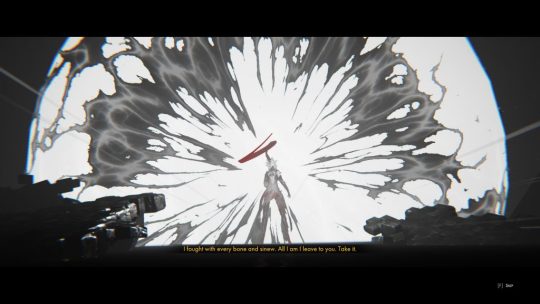
Every four days, the boss of this particular sequence will be made available to fight. Come the seventh day, the boss fight becomes mandatory if you haven’t already challenged it. These are the biggest, toughest, and most dynamic encounters in the game. Beating the boss moves you to the next week/era, but losing instantly ends the Recollection. Starting a new Recollection lets you select from unlocked perks and bonuses going forward, with better bonuses and more currency to spend based on your previous performances. Rinse and repeat, getting stronger each time until you make it to the end.
“The enemy design in Othercide is full of twisted, fleshy and misshapen creatures that wouldn’t look out of place in Bloodborne or any Lovecraftian tale.”
The major gameplay loop of Othercide is split between battles and team management. The daily missions will primarily be Hunts (kill all enemies), but there are occasional variants. I’ve seen Survival (wait until an exit zone spawns, then get your units to it), Rescue (escort a helpless unit to an exit zone), and Ritual (delay and kill one enemy before it completes a ritual that instantly kills your squad). I found these alternate types to be very sparsely occurring though. For the most part, you’ll be deployed with the intent to clear the map.
With all that preamble, let’s talk about how the battles work. You’ll select your units and then be taken to the stage. There, a timeline will display at the bottom of your screen, with units moving up or down it based on their actions. When they hit 0, they act. As such, you’ll want your units at the front of the timeline and need to stall or focus fire enemies down before they can act. Managing the turn order is the crux of any battle, and minimising the enemy’s actions while maximising yours is the aim.
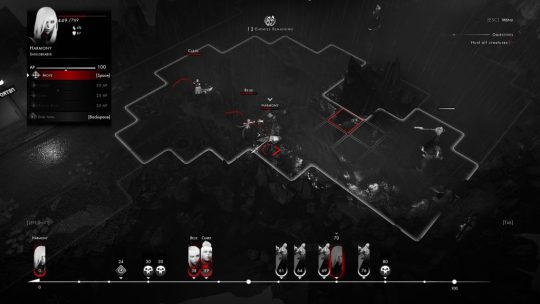
When your units get a turn, they can spend Action Points to move and use any combination abilities. You’ll have 100 by default and can get more as they level, with instant actions typically requiring 25-30. However, if you end your turn with at least 50 AP remaining, that unit will act again much sooner than if fully depleted. What this means is that you’re incentivised to play conservatively, saving your burst windows for when you can avoid being punished for it. It’s a good system at heart.
You’ll frequently find enemies that will set up Delayed Actions, which usually hit hard or affect targeted areas. Avoiding these or delaying the enemies becomes the aim of the game. Your units can also utilise Delayed Actions, but you’ll have access to extremely few of them, which is a shame. More common are Reactions and Interrupts; these are abilities that have a health cost to use, but will do powerful damage and effects when their trigger conditions are met. Interrupts also have the benefit of canceling enemy attacks and performing a counterattack.
As an example: my gun-wielding Soulslinger has 100 AP. Her Shoot ability costs 25, so I can use any combination of one to four attacks. I might stay in place and use two shots, preserving 50 for a faster turn. Or, I could move 17 points of tiles and shoot three times, dishing out more damage when I can avoid the reprisal, and then moving back a single tile to break line of sight. If I cannot avoid a counterattack, I can still burn a HP cost reaction to interrupt the first attack on me. There are lots of theoretical options.
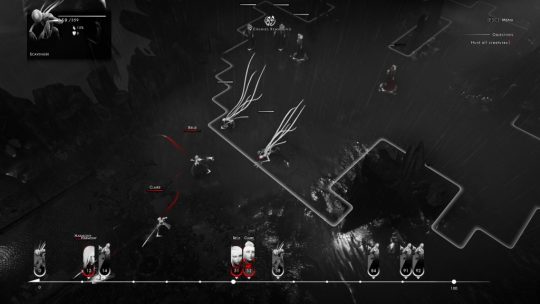
With a wide variety of hideous creatures arrayed against me, each with unique patterns and abilities, the possibilities for Othercide’s combat seem pretty varied and intricate. Unfortunately, my disappointment blossomed when I found how little reward there is to actually do anything except play safe and utilise basic moves. This all hinges on that single flaw: HP costs for many abilities. See, characters will permanently die if reduced to 0 HP (unless a rare resource is spent to revive them), and healing options are almost non-existent. To properly explain why, we need to talk about the unit management.
Your units are all Daughters, borne of the Mother from the tutorial. You spend a resource called vitae to create them, assigning them one of three classes: Shieldbearers (tanks), Blademasters (damage dealers), and Soulslingers (ranged damage/support). Each class has a unique set of abilities, and you get to choose one of two when the Daughter reaches a level milestone (2, 5, 10 and 15). There’s some variety in starting stats and ability configurations, but each class is generally going to have the same core abilities.
Daughters can be powered up in four different ways. The first and most obvious is leveling. Experience is given by completing missions and daughters level up from this with increased stats and potentially new abilities. You can spend vitae to equip Memories to their individual abilities, which add various modifiers. Memories drop from enemy kills, and can do things like increase damage, critical chance, or add effects like armour reduction or turn delay. Lastly, daughters have the chance to gain traits after combat, granting them permanent bonuses (though some also come with negatives; reducing XP gain for higher crit damage, for example).
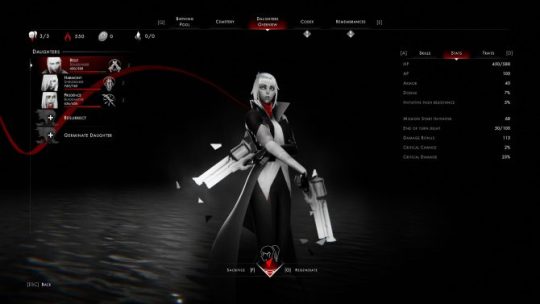
Of these three methods, the gains from leveling up are the most significant. Even with identical traits, abilities and memories equipped, a level 7 Blademaster will outstrip a level 5 one by a good margin without fail. The only way to gain experience is through doing missions, with more gained the harder the difficulty of the battle. You can supplement it through other ways, but if the daughter doesn’t fight, they don’t become very strong.
“Should you want to do as I did and make a “Flesh Voltron“, that’s a possibility.”
But there is a fourth way to power up a character: Sacrifice. It’s possible to kill one of your characters off in order to grant a powerful trait to the recipient, as well as fully healing them. You can also stack these traits if you like; though you’ll only ever see one listed, the stats do go up. If you can spare the units and the vitae to produce more, this can definitely add to their power. Should you want to do as I did and make a “Flesh Voltron“, that’s a possibility.
This is, unfortunately, where the entire system begins to unravel. Sacrifice has the caveat of requiring a daughter be the same level or higher as the recipient in order to be used. Beyond sacrifice, you cannot heal your characters any other way. It’s possible to revive a dead daughter, but the resource to do so is very rarely acquired outside of new Recollections. If your highest level character is on low health? You either leave them on the bench, risk them in battle, or feed them into a lower level character to hopefully make them stronger. To make it worthwhile, that lower level character probably also wants to have an injury that needs healing, which means they’re likely still being benched until such an occasion.
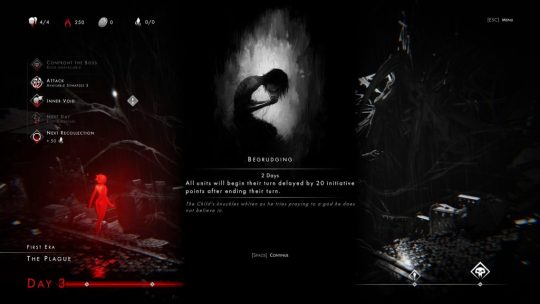
But this ends up slowing your progression even further. Remember how I said that higher levels are the biggest crux of your power? Well, even a character with a sacrificed trait is still going to have to grind up. Sadly, Othercide’s XP gains make it just that: a grind. When you can’t have a character fight more than once a day, you only get a handful of chances to net them experience.
That wouldn’t be an issue in itself if the battles were fun, and up to a point, they are. Astute readers may remember, however: all your reactions and interrupts have a HP cost to use, which is a percentage of the unit’s max. And this is why it all started to come apart before too long.
Enemy damage can be pretty high, so you’re encouraged to avoid taking it. Unless you’re going to take more damage than it would cost to use a reaction to negate it, there’s very little point to actually doing this. All the intricate combos you can perform hinge on these conditional triggers, so instead of doing anything interesting? I just found myself playing safe and utilising basic AP consuming attacks. And this got immensely dull and grindy very quickly.
Othercide’s systems have so much potential in them, but they fall so short because of these few design oversights. It’d be really fun to set up intricate combos and manipulate the timeline, but the reward is not worth the risk and cost. Instead, the best way to get ahead is just to play safe, delay opponents, and use your most basic abilities. Playing things interestingly just doesn’t do enough extra damage or effects to warrant the effort. Nothing kills the desire to experiment with interesting combos when just “move and attack twice” is easier and more effective by a good margin.
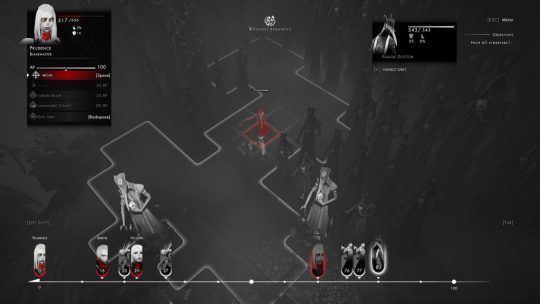
The only caveat to this is during the boss fights. In fairness, the boss fights in Othercide are pretty awesome. Bosses are well designed and fit a specific theme of the enemy types, and they’ll chime in during your runs with sinister warnings and threats. Mechanically, they’ve got large health pools and different phases of combat, with different abilities and tactics required for them. Their ability set is such that sacrificing your HP in exchange for extra damage and mitigation just might be necessary to get through.
What’s less awesome is having to fight the bosses (or even general enemies) again on subsequent Recollections. Enemy stats don’t scale, so after overcoming the boss for the first time, they’ll probably be a cakewalk on subsequent playthroughs. It’s possible to spend points to skip these earlier Eras and get back to where you were before, but that’s also less opportunity for gaining XP. This is mitigated somewhat by later Eras just having more XP from missions in general, but I still couldn’t help but feel like I wanted to spend my unlocks elsewhere. It was just one more little annoyance in an increasing pile.
I really struggled to continue to play Othercide. Eventually I was going through the motions for so long that I just couldn’t bear to carry on. It’s entirely possible that later abilities or unlocks could mitigate the situation, but if there’s no sign of reprieve for multiple hours of grinding at a time, players are unlikely to struggle onward. This is where I found myself, and while some may press on and find more satisfaction from the core gameplay, I couldn’t do it. I can’t stress how disappointing this was to me, because I seriously wanted to love it from the outset. There is so much potential in the systems here, but they’re either not well utilised or balanced in such a way to disincentivise more creative play styles.

Games like Darkest Dungeon or Fell Seal: Arbiter’s Mark mitigate this with a variety of character classes or potential builds, but there aren’t nearly enough to do that in Othercide. Likewise, the long-term research and base management of something like XCOM does a lot to help a campaign’s variety. There’s just not enough of that here — even with at least one new class to access later — and doing interesting things just sabotages my run and forces additional grind on top of an already high baseline.
The only real standout feature here is the presentation, as mentioned earlier. There are times when the creepy, stylised nature crosses into overly edgy territory though; particularly when a daughter will activate a HP cost ability by slashing their wrist for the rare spurt of red colour. Othercide’s narrative isn’t a primary focus either, though it does have fascinating lore and worldbuilding. It’s just not enough to carry it forward, and too often devolves into being proper noun soup until enough intentionally vague information is uncovered to figure out what’s happening. There’s definitely stuff to pick apart and digest, but it really wasn’t enough to encourage me to push on when the gameplay simply didn’t land.
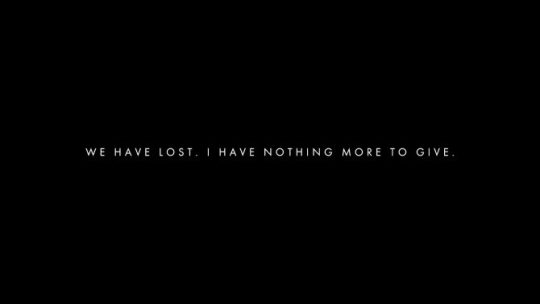
“It seriously hurts that I didn’t like Othercide.”
As a quick note, the technical state of the game on PC is fairly solid. I experienced almost no technical hiccups that weren’t already accounted for and should be absent from the release build. I will say that the game was likely designed with a controller in mind; playing with a mouse and keyboard as I was, I’d frequently have little moments were movement or controls would be “sticky” and unresponsive and would need a couple of clicks to get it right. Not a big deal for a turn-based game, but it happened enough to give pause, and tends to be common in games designed around a controller.
It seriously hurts that I didn’t like Othercide. I can see the potential in it, and I really can’t overstate how impressive I found the presentation and style of it all. I wanted to like it and recommend it so badly, I really did. The core gameplay idea is solid, and it’s still quite possible to find enjoyment here. There are just too many little issues however that snowball into an avalanche of gameplay problems that I couldn’t reconcile.
The end result is that Othercide just failed to land for me. It’s entirely possible that the developers are able to adjust numbers and patterns a little to make something more enjoyable, but until that time? I struggle to see myself recommending it to most people. Give it a shot if you’re a devout fan of the genre or really revel in the graphical style, just don’t expect anything too significant.
July 27, 2020 6:00 PM EST
from EnterGamingXP https://entergamingxp.com/2020/07/othercide-review-the-suffering-other-has-won/?utm_source=rss&utm_medium=rss&utm_campaign=othercide-review-the-suffering-other-has-won
0 notes
Text
Socialism is a pipe dream.
Socialism struggles in the US for the same reasons it struggles everywhere, because it is essentially a failed attempt to compromise with capitalism. Robust social programs, more direct government employment, somewhat more representative governments, high tax rates especially on top earners and corporations, a nominally stable labor movement (essentially a stagnant one at best, really, with vivid decline in many countries and an ongoing battle to avoid decline in others): we call this "European Style Socialism". Sure they appear "less" dysfunctional than our own way of life, but their elites still siphon off the wealth of society and sock it away in money laundering states, their millennials still can't afford homes without the help of their mummies and daddies, they still have their 1%ers, their political systems are still profoundly undemocratic con games designed to prevent real rule by the masses at any cost, and crucially they still benefit from a long, long history of plundering, polluting, debasing, corrupting, enslaving and destroying every part of the planet they could reach during at least as far back as the colonial period (and arguably much farther back in time than that) and continuing on into the current age and the foreseeable future. In America we have a tradition of greed, racism, "individualism", and veneration of property rights above all others that combine to make our particular incarnation of capitalism particularly hideous, but don't kid yourself: Socialism is struggling everywhere, and just as its popularity is building, its actual influence on political outcomes is diminishing. The rulers of this world understand dimly that their destruction of the planet is going to cause a lot of people to die in the not too distant future. But that's okay with them, since at the same moment in history technology is poised to replace the middle and lower classes with robots and computers, and thus the only thing those people have that the elites value--their labor--is going to be valueless to them. And what do the rulers of this world do with things they no longer value? I think we all know the answer to that. Socialism is a pipe dream. It can't save us from the havoc that's coming. Even if it were a truly desirable way of organizing society (and I am quite skeptical of this, as all socialist regimes I have seen still exploit labor; they still never truly redistribute wealth, but only income; they still rely on raw materials extracted in environmentally dangerous ways by people who are often enslaved and always underpaid and overworked; they still punish poverty more aggressively than they punish corruption; they still value stability over justice; they still have political systems with high-stakes elections, and most of their political leaders are rich; in short, they still exist primarily to protect the decadence of the few from the hunger of the masses.), it's not an extreme enough solution to the extreme hazard of this era. The only meaningful difference between socialism and what we have here in the US is that the rulers of European-style socialist countries answer that hunger with gestures of kindness (where practical), whereas here in America the only gesture the rich ever give to the poor is their middle finger. But make no mistake, the hunger is on the rise everywhere, and the elites are increasingly determined everywhere to stop it at any cost. Fuck socialism. I don't want a compromise with capitalism: I want to destroy capitalism. --Grant Metts
1 note
·
View note
Text
Victorian era in London

isekai nonbiri nouka manga happens in the manor home of Ciel Phantomhive, the twelve-year old-head of the noticeable noble English family and also happens in Victorian era in London. Aiding this small plutocrat is Sebastian Michaelis excellent servant, that requires for just to please his youthful master's every requirement. You might ask for-- what sort of target market am I, to become so promptly wondered a just easy servant along with by an aristocrat? Well, I'm called for to emphasize the truth that Sebastian is just no regular servant, and we promptly concern comprehend that there's even more to little Ciel and also creative Sebastian's link as the story continues. This great slave isn't simply helping Ciel from the benefits of his center or for virtually any kind of prosperity, however rather will certainly the Phantomhive mind as each area moves with a somewhat dark arrangement-- which is progressively being untangled. The account is wonderful and also despite the fact that often it might appear that some sections were only a little slow-moving and also didn't generate whilst the just as much value each is important and also essentially satisfying to see. For that reason, the tale itself is really distinct and definitely a remarkable research. In addition, although it could in some cases appear without anything, it'll absolutely not disappoint in appreciating it easily and making you laugh.
Art (10/10):. The art in isekai nonbiri nouka manga is for me not exceptionally hideous. Nearly quickly one of the most effective, I'm sure you'll be pleased. The abilities when revealed show a fantastic picture and also are terrific. The art in isekai nonbiri nouka manga is in it stands for the Victorian duration terrific. I attract concentrate on the fancy apparel styles which are made use of the nineteenth century tea by our figures and china designs, along with the within the Phantomhive method. Additionally changing onto the kind styles themselves-- I need to figure out that they're among the very best I've seen. Sebastian's search floodings problem style and also design; while upon choosing a look into Ciel's personality you immediately determine an atmosphere of merit, brains, as well as course. The-art in my viewpoint is amongst the greatest elements of this manga.
Characters (10/10):. The characters are an absolute plus for isekai nonbiri nouka manga. Ciel Phantomhive is just a twelve-year old business-savvy natural born player who's currently the respectable Language Phantomhive family's top. He prides on being a well mannered, grown-up as well as loosened up child and also likes effective, may it be in a to achieve content products and even to obtain anything of more well worth-- hence forth revealing his curiosity as well as hard to think efficiency in playing games. Moreover, Ciel may be Sebastian's understanding whom he takes into consideration as somebody and also his pawn who is planned to endure something within Phantomhive's name.
manga online - Hence getting the sly however outstanding personality of Sebastian Michaelis whilst the servant of master Ciel us. Sebastian is let me tell you, the best slave to in fact function nobility as he displays his capacity to prepare like a knowledgeable cook, clear so well he leaves not truly a fleck of dust, keep up with the yard and indubitably carry out a number of other tasks while still locating the period to develop his grasp some tea as well as dessert. As he's the very initial slave in order to battle and also battle his opponents with simple eating utensils awesomeness is extra verified. Yes, Sebastian may be the appropriate personification of quality. Nonetheless, whilst the tale breakthroughs-- Sebastian's accurate personality ends up being more and more noticeable.
Something I need to exactly claim worrying both primary numbers and of all of the extra supporting numbers aswell, is the reality that each private includes a special background to notify. Each figure has a fair bit to supply though skills are currently being subjected progressively-- it's really clear. What's not much less is the reality that even though story is normally situations developed to not be light; there are great deals of figures which are prepared to supply relief that is humorous at any moment. As specified previously, each number has quite a bit to offer in the direction of the total history from their character.
Satisfaction (9/10):. I'm certainly experiencing isekai nonbiri nouka manga. That's to end up being anticipated of the manga that's still producing and proceeding with assumptions although a lot of issues have actually already been set off. Furthermore, as each area has actually been released, worries are now being reacted yet a lot more issues are now being help with-- as a result peaking my interest to some bigger level. isekai nonbiri nouka manga can be an ideal harmony of secret unnatural movement and wit that's makes an extraordinary manga. Furthermore-- because it includes several "hot bishes/shotas" ^_^ this truly is specifically appealing to the females;;.
General (9/10):. On the whole, I 'd suggest isekai nonbiri nouka manga to anyone that's considering reading a manga having a twisting and also unique tale, outstanding chracters all whom vary within capabilities as well as their individuals with awe inspiring art work. I'm totally enjoying it which I want others can pertain to like it also! Or if you're burnt out and also intend to read manga online, allow's begin with this one.
Please visit https://findjapanesemanga.my-free.website/sf4t69h08jj47x1tpxqsf learn more related information
1 note
·
View note
Text
breath of the wild is pretty good
my roommate @exexunderscore has been kind enough to let me play his copy of BOTW and his switch and i feel bad bc on twitter all i do is trash it!! i can easily mention the things that bug me bc theyre not spoilers and most of the stuff i like in the game is spoilers or things that would be fun to discover on your own. then i remembered tumblr has a read more function so i can post spoilers over here: here’s my pros and con list of BOTW and how i feel about it in general. i was mean on twitter and said it was a 7/10 game but its like a 7.5 out of 10. its good!! im just nitpicky.
VERY GOOD THINGS:
the enemy AI is fantastic. they did a great job programming these little assholes into doing shit ive never seen-or expected- in a zelda game. i love when moblins pick up bokoblins and fling them at you. its legitimately hilarious. and i love how when they idle they dance around fires and hunt pigs. they’re so full of character without making them sympathetic.
the biodiversity is great. i love all the lizards and birds and dogs and animals and PEOPLE populating the world. the world actually feels alive. i lost my mind when i saw my first bear and rode it around a mountain for a while. i also love how some animals are assholes too and will just run you down if you get too close to them. an emu knocked me off a mountain once and i couldnt even get mad. i was laughing so hard.
the character design is darling. it feels like a perfect midpoint between 64 zelda art aesthetics and windwaker-era coloring/shading. its really charming.
zelda, her character, is VERY good. a little cliche but a big departure from the zelda we’ve seen in the past where shes confident and perfectly composed and idealized out the wazoo. this zelda is vulnerable and irritated and frustrated with the position shes in.
the clothes/ability to dye clothes......[kisses fingers like a chef]. nintendo add more colors in dlc
the ability to tame/ride any horse you want, that you wander on in the wild, is executed really well. its challenging and fun. WHERE!!!!! ARE THE PINK HORSES!!!!!! I CANT FIND THEM I KNOW THEY EXIST
the puzzles are really fun, really thoughtfully made! they’re the perfect amount of difficulty, there’s only a few that are hideous and unfun (MOTION CONTROLS.....). the shrines are short and sweet. similarly, dungeons arent too long and wear out their welcome.
and the abilities you get with the shiekah sensor are actually super useful all the time instead of the zelda curse of getting a weapon/item thats useful for one dungeon....and thats it. i think the one i use the least is stasis but it still has some really fun stuff you can do with it
there are characters/areas of the map named after characters from old zelda games! O: not like as a fun easter egg but like they were historical figures who had things named after them! like linebeck island!
i get to take pictures
STUFF THAT KINDA SUCKS:
gerudo town has some pretty wack shit in it for 2017
the voice acting is so bad it actually actively detracts from the game quality. my friend ascribes the phenomenon as the result of “one take terry”.
the house you can buy sucks and nintendo totally misunderstood why people like houses in video games. its a rupee sink. its more than useless.
the writing quality sometimes dips really randomly. sometimes its just really stupid and bad. i feel like there are parts they handed over to certian writers that did a shit job on their assignment. both shiekah researchers come to mind.
nintendo let me register non-horses as mounts
nintendo where are the poes and redeads
nintendo why did you get rid of auto-jump
okay but for real im looking forward to dlc that adds more enemy types.
beedle doesnt say the thing
while the world itself feels alive with animals the towns and cities feel REALLY empty. like i get hella people died 100 years ago but comes onnnnn i like interacting with people....gimme gimme.
17 notes
·
View notes
Text
Just how to Build a Cheap Computer
Edit Post How exactly to Feature a Creative Commons Work If you encounter material or pictures registered with Creative Commons (like every one of the content and photographs on wikiHow), it truly is your liability to credit the creator inside the manner they specify. These recommendations are distinct in theory, but many individuals who apply CC permits to their function don’t identify how they would prefer to be linked. Used, heres when utilizing Creative Commons ways to manage the attribution demands licensed material. Advertisement Ways Keep intact any trademark notices for your commons licensed function. In case a work youre applying includes an observe that says ” 2008 “, you CAn’t backup it. If such a notice does not search, there is no need Darwinessays to decide on a notice that is certain. You ought to, however, add “Used in Combination With Permission.”, or something compared to that impact. Understand that the symbol’s lack does not imply it is not copyrightedyou may nevertheless have to recognize the resource and your consumption.
Sproul, important realities of the religious faith, (wheaton, illinois tyndale house 1992).
Advertising Credit the writer, licensor and/or different parties (like a wiki or record) within the manner they identify. In case a inventor has a notice mounted on her work that affirms, “Please attribute Molly Kleinman since this work’s inventor,” subsequently feature Molly Kleinman. If you have no note, but there’s a trademark notice (see above), attribute the copyright owner branded within the copyright notice. There is a username although if there is no notice or copyright notice, verify the creators report if it identifies just how to attribute the creators work, to see. Attribute the consumer name, if it doesnt. When there is no founder or writer name of any sort, but there’s a website (like wikiHow), feature the web site by name. Utilize unique games where possible. Include the following factors in many attributions: The title of the work: contact it by brand, in the Event The work includes a concept.
Extremely rarely are adult fleas noticed before the reproductive procedure has initiated.
If it doesnt, you can simply state “This function by Molly Kleinman” or just “Untitled, by Molly Kleinman”. Use whichever causes it to be clear where the job descends from and looks ideal. The URL for your work Link back to the first supply of the job. It can be suggested that could be the attribution notice’s most important part. It can benefit designers keep an eye on locations where their work looks by experiencing what links are operating traffic with their sites. Additionally, it offers a simple way to people of the function to locate the initial supplier. If you are reproducing a -certified workin a print structure, you might choose to not add a website that is lengthy and hideous, and there might be scenarios where departing out a link is appropriate. But in basic, the web link may be the most valuable area of the attribution. The URL for the Commons license: URL To the license.
It’s generally known as lithography.
The initial work needs to have a the certificate under which it had been produced; link to the exact same spot. That you do not have to range from the license’s full text when you recreate a CC – registered function. Utilize the Commons license contractor for simple era of the common attribution. A clear standard method is to format the attribution of the CC – function that is accredited: Goto. Click the key “Pick A Certificate.” Find the stereo buttons which might be befitting the license you’ll need, fillin the wrinkles that needs to be loaded in, and then the key “Pick A Certificate” below. It’ll then exhibit the HTML that is full that you should copy composite that is / towards the page. The permit impression can look on your own site.
Use numbers to precise figures 10 and above.
While you fill-in the permit turbine, you’ll find blue help links that may describe each option when you go along. If, for any explanation, you can’t access the creative commons site to build a permit, just include the next: ” CC- (?) 2008 Molly Kleinman). The info (?) is found within the article Just How To use a creative commons license. Advertising We could genuinely utilize your support! Can you inform US about Swimming and Fishing? Yes No Skating and Diving Just how to swin backstroke properly Can you reveal about Decorating? Yes No Decorating How to provide or enhance an den Can you inform US about Martinis?
All learners, over the globe are currently seeking help from writers that are qualified.
Yes No Martinis Steps to make an martini Can you tell us about cooking? Yes No cooking How to chestnuts in an oven For helping thanks! Please reveal everything you find out about… Tell all you realize below to us. Remember detail is not worsen. Recommendations Provide Facts. Please be detailed that you can inside your explanation. Don’t worry about formatting!
Make an effort to suit the undertaking for your type that is working.
We will take care of it. Like: Don’t say: Eat more fats. Do say: Include fats with a few vitamins and minerals towards the meals you previously eat. Attempt butter coconut oil, grape. Publish Methods All attributions are CC-BY. Different designations are included as vital. Licenses are sometimes updated.
Let us start to see the schooling troubles and answers there.
For instance, the CC Attribution 2.0 Common hasbeen updated to CC Attribution 3.0 Unported, and CC Attribution 4.0 is scheduled for discharge at the conclusion of 2012.[1] While you still see-the CC-BY attribution, the legal rights touse the certificate have transformed. When you read CC-BY, the permit is clearly CC-BY 3.0, the 3.0 is not typically published since all CC- BY attributions should today conform to the 3.0 specifications. Though this is not an excellent big-deal for most people, it is not bad to know in-case the appropriate limitations adjust. The permits do not need you to notify a creator that you are using her – work, but its a nice thing wherever it is possible to do. Many people have become very happy to understand that somebody is currently using and building upon their creations ; licenses in the first-place. Alerts Do anything you want withit, or does not suggest you can post in anyplace, simply because the work is certified under Creative Commons. When the permit is CC-BY, attributing the task to the initial writer is all that you’ll require. The following CC licenses, nevertheless, have added rules or demands:[2] Attribution-NoDerivs (you might not alter, change, or develop upon this function.) Prepared CC-BY-ND.
– be sure the mistress has adequate assets to produce a lawsuit advantageous.
Attribution-ShareAlike (in the event you change, transform, or develop upon this function, you could possibly disperse the ensuing work merely underneath the same or related permit to this one.) Published CC-BY-SA. (should you change, transform, or assemble upon a Share Equally work-you should however credit the original creator by attribution.) Attribution-NonCommercial (may very well not use this benefit commercial applications.) Composed CC-BY-NC. Theoretically, unless otherwise chosen, all licenses are Non-Commercial. Attribution-NonCommercial-NoDerivs (you might not use this work for industrial functions; you might not change, convert, or develop upon this work.) Composed CC-BY-NC-ND. Attribution-NonCommercial-ShareAlike (you might not make use of this work for industrial reasons; in case you modify, convert, or assemble upon this work, you could distribute the ensuing work just beneath the same or similar permit to the one.) Written CC-BY-NC-SA. (should you modify, change, or create upon a Share Equally work-you should nonetheless credit the first writer by attribution.) An essential point to remember is that regardless of the permit, the thing must be accompanied by the initial attribution. CC -SA- Molly Kleinman with changes by Steve Jones is suitable, nevertheless the CC-SA- BY Kleinman portion is needed.
The post Just how to Build a Cheap Computer appeared first on CADH.
Just how to Build a Cheap Computer published first on https://facialoralsurgery.tumblr.com
0 notes
Text
A Comprehensive Review Every New NBA 'City' Uniform
The biggest NBA news of the day is that Baron Davis and Laura Dern are dating, but the second biggest news is that Nike Released their designs for every NBA team’s “City” alternate jersey, which are jerseys inspired by cities or some shit. I looked at them and wrote about them, like a normal sports blogger does.
GOOD:
CHICAGO:
It’s the flag, and it’s a nice flag everyone is very fond of. I am worried about players spilling chocolate on their unis, though. That would be very embarrassing, I think, to walk around with a big ol’ chocolate stain on your nice white uniform. High risk, high reward play, here.
PACERS:
It has a checkered flag, like a race car. I like race cars. I like that they go vroom vroom very fast.
CLIPPERS:
Look I don’t know what the fuck is has to do with boats, or why the team is wearing Miami Dolphins colors, but teal is an NBA power color and you have to respect any team that dons it.
BUCKS:
Eggshell tones baby! Perfect for the river-yacht or a chilly, fire-lit library, with a tasteful stripe down the middle to bring it all together. This is the midwestern thinking man’s alternate jersey. Also they say “CREAM CITY” on the bottom, which is where I live, work and play, spiritually.
MAGIC:
If you don’t like these, you need to smoke more weed. One time I was EXTREMELY blitzed off THC drops at the Hiram M. Chittenden Locks in the Ballard neighborhood of Seattle, Washington, and I spent like ten minutes in the gift shop, looking at the t-shirts they were selling. I thought the drawing was really nice and for a hot second I thought, damn I need one of these motherfuckers REAL bad but then my good brain, not my stoned brain, kicked in and way like “Hey Corbin, man, you’re probably too stoned to make this purchase, this shirt isn’t that nice dude.” Anyway, if I was still using, and I encountered this jersey in that state, I would HAVE to buy the Bismack Biyombo manifestation of this jersey, just spend whatever obscene amounts of money was requested of me, and regret the purchase in a very true and real way while also savoring my stoned wisdom in that time. This jersey rules.
SPURS:
I get that, as a left leaning-dude, I’m expected to hate black and white Spurs-branded digi-camo. But by making the camo black and white, it goes BEYOND a tribute-to-the-troops and turns a bunch of dudes who plays a game for a living into members of a private mercenary gang that kills its enemies with hoops. Watching capital inadvertently debase the world spanning military colossus that keeps it in power is kinda funny, I think it’s good.
SIXERS:
EXTRAORDINARILY classy font! Finally, the play of Joel Embiid is being recognized for what it is: a luxury product, grander than any wine, any gold topped chocolate bon bon, any gentle scented oil, rubbed into your back by the world’s strongest and most skilled masseuse.
ROCKETS:
At first glance, it’s maybe a little weird that the Rockets have Chinese writing on a jersey that is meant to celebrate the city of Houston, a city where most people speak English. But, clearly, this is the harbinger of the future for the franchise, which is going to move to Beijing as soon as possible. What’s my source? THAT’s my source buddy! BEIJING ROCKETS 2018-19, DON’T TRY TO HIDE FROM IT!
UTAH:
Evokes the 70s, cocaine. Maravich belongs in this jersey.
KINGS:
The Basketball is a Lion King. He will stand above all other balls and roar, and the other balls will bow at his might until, one day, he is killed by another basketball, his brother who is also a basketball. His son, a basketball as well, will get revenge and take his place on the mountain, though.
BROOKLYN:
It’s a Nets Jersey. It’s black and white and it looks nice. Not everything needs to shatter molds.
MIAMI:
I wanna make a joke, but what, I’m made of stone?
KNICKS:
I like firefighters and no one can say otherwise.
BAD:
CELTICS:
You guys aren’t gonna believe this, but the Celtics have a boring looking alternate jersey to compliment their boring looking regular jersey. Features grey. More on that later. We are living in the wildest possible times.
LAKERS:
Kobe Bryant designed these. They’re supposed to look like snakes, because Kobe branded himself as a snake. Kobe spending his retirement trying a bunch of sports-adjacent shit he’s not good at and getting deferrence because he is Kobe Bryant, The Player Who Scored A Lot, is maybe the most embarrassing shit I’ve ever seen a professional athlete do. It would be less embarrassing if he was posting videos where people pissed in his mouth or making sly pro-Trump allusions to reporters or taking 125th place in Scrabble tournaments.
CAVS:
It is, I think, truly stunning how terrible these things are. They are, first, off, grey. You know, grey? The color of cloudy days and paved over fields? The color that only looks good on dads, while they swing hammers or pick up their children, or whatever? And then, the only color that REALLY compliments grey, which is yellow. You know. Like a paved road, that thing everyone thinks has a cool color? I mean who can blame Nike, I suppose, when LeBron James, the world’s most famous athlete, is the human being who is your most prominent non-Jordan pitchman, you gotta put him in the ugliest shit imaginable
OKC:
Honestly, It’s impressive how awful these are, soup-to-nuts. No one who made this had even one good idea they put into the final product. Every OKC jersey is bad, of course, on account of the team’s very existence being born from the poison seed of theft from Seattle, but… Gradients!? GRADIENTS!? A grey-to-grey-gradient? Why, on God’s green earth, is Nike fucking so hard with Grey, a color, not even a color, a SHADE, that has inspired exactly no people, ever? They like grey so much that they put TWO DIFFERENT KINDS of grey in this piece of garbage, and subtly mixed the two greys so that there would be nearly infinite manifestations of grey betweens the main greys. This jersey is seeking the limits of grey itself, the deepest grey, the grey at the edge of our understanding of grey.
WASHINGTON:
All the chocolate staining potential of the Chicago jersey, none of the evocative shit. These are maybe, low key, the worst one.
ATLANTA:
This evokes bees, not Hawks. Would someone please put feather texturing on these jerseys, like the world has been demanding all these years.
DETROIT:
These say “Motor City” but do not feature any pictures of cars, which I love because, like I said earlier, they are fast and they make loud noises. The move here was an updated version of the mid 90’s Grant-Hill vroom vroom firehorse, but Nike isn’t listening to good sense!
GOD ONLY KNOWS:
WOLVES:
Look, I’ve talked a lot of shit on Grey, which is Nike’s favorite color right now I guess, but I can accept it here. Minny winters are insanely grey, wolves are grey, this all makes thematic sense. But also: good god grey is ugly. Don’t wear grey!
MAVERICKS:
These are bad but they’re like so bad that I think they almost fly around the moon and become good again? They are a bad uniform that lives somewhere out of time, a look that has never been cool in any era, but in that fact I think they gain a kind of integrity. There’s a possibility that, someday, in 2067 or some shit, these will have been regarded at an innovative step forward in jersey aesthetics, even if we think they’re hideous now. Cop them and freeze dry to sell in the future.
WARRIORS:
That shade of yellow is hideous but the logo is cool? “The Bay” is some real San Francisco bullshit though, one of those subtle org-wide attempts to separate the team from Oakland before they strip the city of the team and move them to rich-ass tech boi SF in a few years.
MEMPHIS:
Honestly I feel weird writing snarky, mildly absurdist jokes about a jersey that is based on signs from a famous workers rights struggle. While I guess I respect Grizzlies celebrating a monumental protest with their unis, the fact that they were designed and manufactured by Nike, a company with a workers rights record that is spotty at best, goes a long way to defanging the allusion. Capitalism: it’s everywhere and it’s amoral!
SUNS:
EXTREMELY PURPLE. Purple is my favorite color and I honestly admire how purple these are, while also wondering… how purple is too purple?
PELICANS:
These are also Purple.
BLAZERS:
Every other Portland fan hates these things, which makes sense because they live in the world capital of streetwear snobbery. I think they’re fine. The plaid is totally unnecessary. If I was making these bad boys, I think I would stick a fat-ass salmon on there, personally. I also think that the mascot should be replaced with a salmon.
HORNETS:
I don’t even know, man. If it were up to me, I would make them play in a white jersey with a fat-ass picture of Michael Jordan’s smiling face on the front, and anything else will just seem incomplete to me.
RAPTORS:
Finally a uniform that tells sports fans: “Hey: my face is up here. I know my body is chugging away down here, but the soul is in the face, and that’s where a person’s TRUE MEANING can be found. Geeze louise.”
NUGGETS:
Nice shade of blue. Fun stripes. Otherwise: whatever.
Okay I did it, this is every uniform. Back to tracking down every last piece of information I can collect and Baron + Laura. Where do they like to go to dinner, you think?
A Comprehensive Review Every New NBA 'City' Uniform published first on http://ift.tt/2pLTmlv
0 notes
Text
A Comprehensive Review Every New NBA ‘City’ Uniform
The biggest NBA news of the day is that Baron Davis and Laura Dern are dating, but the second biggest news is that Nike Released their designs for every NBA team’s “City” alternate jersey, which are jerseys inspired by cities or some shit. I looked at them and wrote about them, like a normal sports blogger does.
GOOD:
CHICAGO:
It’s the flag, and it’s a nice flag everyone if very fond of. I am worried about players spilling chocolate on their unis, though. That would be very embarrassing, I think, to walk around with a big ol’ chocolate stain on your nice white uniform. High risk, high reward play, here.
PACERS:
It has a checkered flag, like a race car. I like race cars. I like that they go vroom vroom very fast.
CLIPPERS:
Look I don’t know what the fuck is has to do with boats, or why the team is wearing Miami Dolphins colors, but teal is an NBA power color and you have to respect any team that dons it.
BUCKS:
Eggshell tones baby! Perfect for the river-yacht or a chilly, fire-lit library, with a tasteful stripe down the middle to bring it all together. This is the midwestern thinking man’s alternate jersey. Also they say “CREAM CITY” on the bottom, which is where I live, work and play, spiritually.
MAGIC:
If you don’t like these, you need to smoke more weed. One time I was EXTREMELY blitzed off THC drops at the Hiram M. Chittenden Locks in the Ballard neighborhood of Seattle, Washington, and I spent like ten minutes in the gift shop, looking at the t-shirts they were selling. I thought the drawing was really nice and for a hot second I thought, damn I need one of these motherfuckers REAL bad but then my good brain, not my stoned brain, kicked in and way like “Hey Corbin, man, you’re probably too stoned to make this purchase, this shirt isn’t that nice dude.” Anyway, if I was still using, and I encountered this jersey in that state, I would HAVE to buy the Bismack Biyombo manifestation of this jersey, just spend whatever obscene amounts of money was requested of me, and regret the purchase in a very true and real way while also savoring my stoned wisdom in that time. This jersey rules.
SPURS:
I get that, as a left leaning-dude, I’m expected to hate black and white Spurs-branded digi-camo. But by making the camo black and white, it goes BEYOND a tribute-to-the-troops and turns a bunch of dudes who plays a game for a living into members of a private mercenary gang that kills its enemies with hoops. Watching capital inadvertently debase the world spanning military colossus that keeps it in power is kinda funny, I think it’s good.
UTAH:
Evokes the 70s, cocaine. Maravich belongs in this jersey.
KINGS:
The Basketball is a Lion King. He will stand above all other balls and roar, and the other balls will bow at his might until, one day, he is killed by another basketball, his brother who is also a basketball. His son, a basketball as well, will get revenge and take his place on the mountain, though.
BROOKLYN:
It’s a Nets Jersey. It’s black and white and it looks nice. Not everything needs to shatter molds.
MIAMI:
I wanna make a joke, but what, I’m made of stone?
KNICKS:
I like firefighters and no one can say otherwise.
BAD:
CELTICS:
You guys aren’t gonna believe this, but the Celtics have a boring looking alternate jersey to compliment their boring looking regular jersey. Features grey. More on that later. We are living in the wildest possible times.
LAKERS:
Kobe Bryant designed these. They’re supposed to look like snakes, because Kobe branded himself as a snake. Kobe spending his retirement trying a bunch of sports-adjacent shit he’s not good at and getting deferrence because he is Kobe Bryant, The Player Who Scored A Lot, is maybe the most embarrassing shit I’ve ever seen a professional athlete do. It would be less embarrassing if he was posting videos where people pissed in his mouth or making sly pro-Trump allusions to reporters or taking 125th place in Scrabble tournaments.
CAVS:
It is, I think, truly stunning how terrible these things are. They are, first, off, grey. You know, grey? The color of cloudy days and paved over fields? The color that only looks good on dads, while they swing hammers or pick up their children, or whatever? And then, the only color that REALLY compliments grey, which is yellow. You know. Like a paved road, that thing everyone thinks has a cool color? I mean who can blame Nike, I suppose, when LeBron James, the world’s most famous athlete, is the human being who is your most prominent non-Jordan pitchman, you gotta put him in the ugliest shit imaginable
OKC:
Honestly, It’s impressive how awful these are, soup-to-nuts. No one who made this had even one good idea they put into the final product. Every OKC jersey is bad, of course, on account of the team’s very existence being born from the poison seed of theft from Seattle, but… Gradients!? GRADIENTS!? A grey-to-grey-gradient? Why, on God’s green earth, is Nike fucking so hard with Grey, a color, not even a color, a SHADE, that has inspired exactly no people, ever? They like grey so much that they put TWO DIFFERENT KINDS of grey in this piece of garbage, and subtly mixed the two greys so that there would be nearly infinite manifestations of grey betweens the main greys. This jersey is seeking the limits of grey itself, the deepest grey, the grey at the edge of our understanding of grey.
WASHINGTON:
All the chocolate staining potential of the Chicago jersey, none of the evocative shit. These are maybe, low key, the worst one.
ATLANTA:
This evokes bees, not Hawks. Would someone please put feather texturing on these jerseys, like the world has been demanding all these years?
DETROIT:
These say “Motor City” but do not feature any pictures of cars, which I love because, like I said earlier, they are fast and they make loud noises. The move here was an updated version of the mid 90’s Grant-Hill vroom vroom firehorse, but Nike isn’t listening to good sense!
GOD ONLY KNOWS:
WOLVES:
Look, i’ve talked a lot of shit on Grey, which is Nike’s favorite color right now I guess, but I can accept it here. Minny winters are insanely grey, wolves are grey, this all makes thematic sense. But also: good god grey is ugly. Don’t wear grey!
MAVERICKS:
These are bad but they’re like so bad that I think they almost fly around the moon and become good again? They are a bad uniform that lives somewhere out of time, a look that has never been cool in any era, but in that fact I think they gain a kind of integrity. There’s a possibility that, someday, in 2067 or some shit, these will have been regarded at an innovative step forward in jersey aesthetics, even if we think they’re hideous now. Cop them and freeze dry to sell in the future.
WARRIORS:
That shade of yellow is hideous but the logo is cool? “The Bay” is some real San Francisco bullshit though, one of those subtle org-wide attempts to separate the team from Oakland before they strip the city of the team and move them to rich-ass tech boi SF in a few years.
MEMPHIS:
Honestly I feel weird writing snarky, mildly absurdist jokes about a jersey that is based on signs from a famous workers rights struggle. While I guess I respect Grizzlies celebrating a monumental protest with their unis, the fact that they were designed and manufactured by Nike, a company with a workers rights record that is spotty at best, goes a long way to defanging the allusion. Capitalism: it’s everywhere and it’s amoral!
SUNS:
EXTREMELY PURPLE. Purple is my favorite color and I honestly admire how purple these are, while also wondering… how purple is too purple?
PELICANS:
These are also Purple.
BLAZERS:
Every other Portland fan hates these things, which makes sense because they live in the world capital of streetwear snobbery. I think they’re fine. The plaid is totally unnecessary. If I was making these bad boys, I think I would stick a fat-ass salmon on there, personally. I also think that the mascot should be replaced with a salmon.
HORNETS:
I don’t even know, man. If it were up to me, I would make them play in a white jersey with a fat-ass picture of Michael Jordan’s smiling face on the front, and anything else will just seem incomplete to me.
NUGGETS:
Nice shade of blue. Fun stripes. Otherwise: whatever.
Okay I did it, this is every uniform. Back to tracking down every last piece of information I can collect and Baron + Laura. Where do they like to go to dinner, you think?
A Comprehensive Review Every New NBA ‘City’ Uniform syndicated from http://ift.tt/2ug2Ns6
0 notes